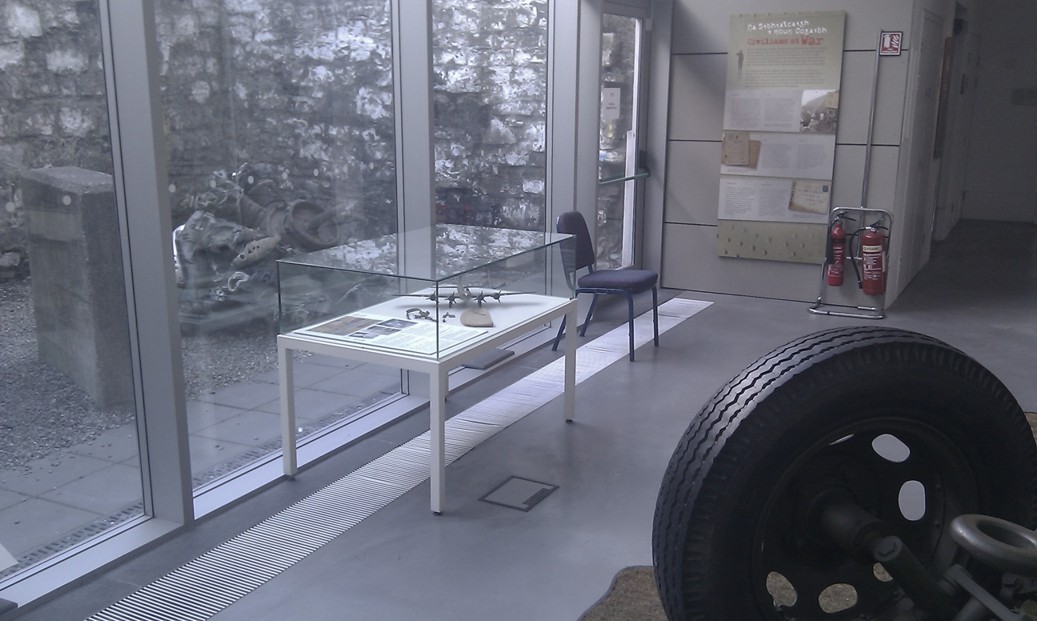Boeing B-17G Flying Fortress, Sligo, December 1943
On the afternoon of 9th December, 1943, the peaceful slopes
above Ballintrillick in County Sligo would be shattered by the
crash of an American bomber.
The aircraft, a Boeing B-17G-15-BO Flying Fortress was being
flown on a ferry flight from Goose Bay to Prestwick in
Scotland. The aircraft was part of the fourth batch of G
model B-17's produced by Boeing and the new sub type was only in
the process of being issued to combat units in England and the
Mediterranean in late 1943. Among other improvements, the
most noticeable new feature of the B-17G was the introduction of
a defensive machine gun turret on the underside of the
aircraft's nose, the remote controlled chin turret.
The long transatlantic ferry flight of this aircraft ended in
tragedy for its crew when it crashed into the slopes of
Tievbaun, the hill north of Mount Truskmore in north Sligo on
the foggy afternoon of December 9th, 1943. Three young members
of the United States Army Air Forces lost their lives as a
result and the seven survivors faced many months of recovery in
most cases. Below you will find the story of the ten men who
flew 42-31420 on her last flight and the tales of the local
people of Ballintrillick and surrounding areas who bravely went
to the aid of injured strangers on a cold winters night.
Local memories of those from Ballintrillick and surrounding
area.
Dan Gilroy, who was 90 in 2008, recalled the terrible weather
the day of the crash. Dan was a miner in the barytes mines
in the Gleniff valley at the time of the crash. During the
week he was on the night shift at the mines and thus was not
involved in the immediate relief efforts. He remembered
knowing that the household of the Rooney's had helped out during
the rescue effort by giving blankets. He also knew Doctor
Evelyn Connolly later Dr. Connolly-Flanagan of Colloony,
Sligo. He remembers her as a very good doctor.
Paddy Rooney, now living in Drumcliffe, but who was an 11 year
old school boy at the time remembers hearing an aircraft flying
very low as he came home from school that day. He and his
family lived at the cross roads at the eastern end of the
Gleniff Horse Shoe road across from Davies pub and shop.
He remembers seeing all the activity of army trucks and
ambulances that evening. The noise and lights were
fantastic he recalls. The village he points out at that
time was not connected to electricity so the activity was all
the more noticeable. He can remember seeing vehicles with
white stars painted on the doors.
Bartly Rooney, no relation to Paddy above, tells a story also
told by Paddy. Both their fathers traveled to the mountain
that night to help in the rescue. One member of the crew
was trapped by the aircraft and the ground. The men
struggled all night to dig away the peat and earth from below to
allow him to be released.
Paddy Rooney recalls being told that it was local farmer Andrew
Gilmartin who first met with survivors of the crash. He
met two men in military uniform on the mountain side while out
on his land.
John Rooney, grandson of Bridget and Daniel Rooney, emailed in
2010 with his memories of the event:
“As I mentioned I was 5+ years old then
but still have good recollections of the crash. We lived on
the flight path of the aircraft been ferried in from
Newfoundland and can still remember formations of aircraft
coming in across Donegal Bay so low we could see the stars
on the underside of the wings. On the night in question I
was of course in bed and one of our neighbours knocked and
told my father ( James Rooney, Keelogues) about the crash on
the mountain . My father dressed and left with my neighbor
to go to the rescue with all the other local people.
During the following days my mother went with myself and my
brother Dan to my grandparents home to help making the
famous tea etc., I also climbed the mountain to the site ;
The plane was largely intact. The props had cut four furrows
in the boggy mountain top for about 3-500 yards and came to
rest in a large shallow dry boghole on its belly. Some of
the engines were strewn along the four furrows at intervals
but as I said, other than losing the engines it was largely
intact. It landed right on top of the mountain which is
relatively flat, were they were flying 10 feet lower
they would have crashed into the mountain face - 10 feet
higher and they would have missed it. A sentry on duty
(American I think) gave me a bar of chocolate - as it was
wartime I think it was my first ever bar of chocolate. Later
in my grandparents home, which seemed to be always full of
military people, a similar thing happened - I was spoiled.
From snippets of conversation I recall men telling of
frozen hands carrying stretchers down, digging out one
airman from under the plane and I always understood that the
two airmen made it to a local house in Mullinfad but of
course they were probably guided there by Mr. Gilmartin.”
The Irish Military archives in Cahal Brugha Barracks in Dublin
contain a file on this crash, G2/X/1255.
The report is a collection of correspondences and official
reports created by the military personnel who attended the crash
and who helped in the rescue and co-ordinated the movement of
injured between hospital and Northern Ireland, trying as best
they could to maintain the requirements of neutrality. One
summary report gives the impression gained by the local Irish
Coast Watching Service Look Out Posts. These were small
concrete shelters located on prominent headlands around coast
and would normally be the first people to encounter an aircraft
such as 42-31420.
”Previous Movements: LOP Mullaghmore
(Donegal Bay) at 17:19 hrs. on the 9th December, 1943
observed a U.S. Aircraft 6 miles N.W. flying very low,
evidently in distress. Almost immediately afterwards
LOP St. Johns Point observed what was evidently the same
aircraft 1 mile south circling and then moving in a south
westerly direction.”
In statements made to their superiors after the event, Irish
Army Lt.'s Melican and Bolger from Finner Camp reported that
that they were among the first to reach the site. Local
civilians had made it to the site before the Guards and
Army. At the time that they reached the site around 21.30
hrs on December 9th, they met with Dr. Connolly and the police
making their way up the mountain. Locals were at that time
trying to release one of the airmen who was trapped and they
refused to stop this work when the military asked them.
As early as December 14th, Capt. J K Birthistle of the Irish
Armies Western Command G2 section filed the report which
follows. Note that this officer was not a local to the
area so his spelling of place names and understanding of the
location comes across in this report.
14 December 1943
Crash of Flying Fortress at Eagles Rock,
Ballaghtrillick Cliffoney, CO. Donegal
Sir,
I have the honour to submit report re above crash.
A Flying Fortress on delivery from America crashed at
Eagle Rock, Ballaghnatrellick (1900 ft. approx.) at 16.15
hours on 9/12/43. She carried a crew of 10 of whom 2
were killed and 8 were injured, the Plane itself was
wrecked.
On arrival in Sligo at 22.30 hours
on the 9/12/1943, I called at the Guards Barracks and
received a message from the Duty Officer, Athlone to the
effect that the dead and injured were to be transferred
across the border in the R.A.F. Ambulances. Two of the
injured were, at this time, in Sligo Co. Hospital. I
called and saw Dr. McCarthy Surgeon who was working on the
patients and informed him that the remainder of the injured
crew would not be coming to the Hospital for treatment.
I arrived at Ballaghnatrillick at
23.15 hours. Two R.A.F. Ambulances had arrived with
personnel – 2 Doctors; 1 Nurse; 2 Drivers and 1 Officer –
all in uniform. We organised a party and with a guide
set up the mountain. From the point where the road
ends to the scene of the crash is 4 1/2 to 5 miles and in
that distance the mountain rises 1900ft, in some places it
is almost vertical. From Ground level the mountain is
in cloud and covered with freezing fog; visibility at any
point is not more that a few yards; the entire going is bog,
boulders and rocks. Time taken to ascend 4 hours and
time taken to descend with casualty about 3 hours.
I could not describe the hardship of
the Stretcher parties in taking the injured men down the
mountain. It is unbelievable that they could take a
stretcher case down in safety, as near the top the mountain
shelves away in 10 to 20 feet rises. Several members
of the Stretcher Parties received small injuries such as
cuts and bruises on legs and arms. Some older members
had to fall out on the way down owing to exhaustion.
It took at least 12 men to each stretcher and owing to lack
of numbers it was extremely difficult to get stretcher
parties. The last one of the injured was not down
until about 07.15 hours 10/12/43 – 15 hours after the
crash. As the injured had to remain in the freezing
fog waiting for parties to carry them down, there were
numerous requests from the Doctors at the top for
stimulants, whiskey and hot-water bottles. I sent up 3
bottles of whiskey and about a dozen hot-water bottles –
these never arrived at the top – some lost under way, the
stretcher bearers coming down consumed some of the whiskey;
as the ascent became too steep the hot-water bottles and
blankets were abandoned.
As the Stretcher Bearers were nearly all from Cliffony,
about 4 ½ miles away, I arranged to have them driven home in
an R.A.F. Ambulance as they were in a very exhausted
condition and we purchased some liquid refreshment for them.
It has been pointed out to Major Sprague – Air Attache
at the American Legation – that splendid services were
rendered by these men. We asked for a list of names so
that these men might be shown some little
appreciation. I have arranged with Supt. Fahy and Rev.
Fr. Curran C.C. Cliffoney, who was at the spot, to furnish
the list of names. I wish to mention the wonderful
help given by the aged couple Mr. and Mrs. Rooney who live
in the cottage at the foot of the mountain. Mr. Rooney
aged 75 years left his sick bed to guide us beyond a
dangerous river bed, before ascending the mountain.
Mrs. Rooney remained up all night, supplied all the
ambulances with boiling water for hot-water bottles and gave
hot tea to each injured man and each stretcher party
and supplied tea to the Military party. She refused to
take payment and only asked that her reserve stock of tea
about 1 ½ lbs be replaced if possible.
My instructions that the dead and wounded would be
brought to Northern Ireland were overruled by the medical
Authorities who stated they must be brought to the nearest
Hospital – Sligo.
At about 5.30 on the 10th I made a second attempt to
climb the mountain with 4 officers and 20 men. I
arrived with 6 men at the plane about 05.00 hours, the
remainder had got separated and lost in the fog. I had
the two dead bodies taken down and handed them over to the
R.A.F. returning to Northern Ireland about 12.30 hours
together with certificates of Registration of deaths.
On calling to the Co. Hospital, Sligo at about 15.00
hours I found a party of American Army Medical Service –
number about 20 – all in uniform, about to take away six of
the injured men, the condition of the remaining two men was
so serious that it was not considered advisable to remove
them. A further report to hand states that an American
Ambulance returned Saturday evening and removed the
remaining two men.
The transport of Friday’s party consisted of 3
ambulances and a utility van. After the ambulances had
departed some of the party in the utility van returned to
the Royal Hotel where they had refreshments and food.
Included in this party was Colonel Simpson, they were joined
by Major Sprague, C/Supt. Leddy and Supt. Fahy."
The Mr. Rooney mentioned in the text was Daniel Rooney, whose
son Peter was active on the mountain that night.
Much of the file in the archives deals with the aftermath of the
crash and the circumstances surrounding the airmen’s kits and
possessions carried on the aircraft. Due to the conditions
on the mountain on the night of the crash, items of clothes and
bedding found discarded on the mountain top were used to provide
comfort to the injured men. These items then made there
way down the mountains with the stretcher cases and were
deposited at Sligo hospital. They were then taken to
Northern Ireland with the returning RAF ambulances. Other
items of clothing came to be used by the guard mounted on the
wreckage in the days and nights following. American
officers visiting the site may have removed some items and the
Irish Army finally carefully accounted for all personnel items
as could be found in the days following as these were handed
over to the American military. Some items were inevitably
went missing with all the many visitors to the site and others
were lost in the boggy ground.
Present in the locality was F/Lt Herbert S Moore of the Royal
Air Force, a frequent attendee in these circumstances in his
roll as liaison officer between the Irish and British
military. He is mentioned in a 21st January 1943 memo from
Colonel F McCorley, the Commanding Officer, Western Command who
was dealing with the issue of the US military equipment that the
American authorities were causing a fuss about following the
chaotic conditions on the night of the crash. His
frustration at the accusations being made in light of the
incredible effort made on the night is very evident.
Sir,
Accompanied by Captain Birsthistle I visited Finner
Camp on the 15th and 16th inst. to make further enquiries re
material retrieved from the above. My inquiries reveal that,
in addition to the articles returned to G.H Q. by Comdt.
Power , Command I.O., several loads of articles were taken
across the Border by American and British representatives.
When the rescue party reached the scene of the
crash they found parts of the 'plane and it's contents
scattered over an area about about two hundred and fifty
yards long. The front part of the 'plane had broken away,
allowing the contents to be thrown out.
The injured men were got out of the 'plane (one had to
be cut out as his limbs were gripped in the fuselage) and
placed on stretchers on the ground. As the cold was intense,
some were placed on sleeping bags, others had sleeping bags
placed over them. Any other garments which could be found
were heaped on top of them.
When the stretchers were carried down the
mountain those articles were still over the injured men and
were loaded into the R.A.F. Ambulances. On arrival at Sligo
Hospital the coverings were left in the hallway before the
men were sent up the ward in the lift. By the time the last
man was brought in, a considerable number of articles were
left in the hall. Before the R.A.F. Ambulances left these
articles were placed in one of the Ambulances under the
supervision of a Lieut. Pierce, R.A.F (Doctor). This
Ambulance proceeded to Cliffony, where it took on the bodies
of the two men killed in the crash.
One of our Officers, Lieut. Bolger, 17th Infantry
Battalion, accompanied this car from Sligo Hospital to
Finner Camp. He saw the material being loaded on the car and
had a conversation with Lieut. Pierce regarding the sleeping
bags.
On arrival at Finner Camp, Lieut. Pierce instructed the
driver to get one of the sleeping bags and give it to
Bolger. This was done and and after a short stay the
Ambulance proceeded to the Border. The sleeping bag was
handed in later by Bolger and sent to G.H.Q.
On the day the Americans took away the injured men from
Sligo they also loaded up a utility van with personal
belongings of the injured men. These were brought down in
the lift from the ward, and apparently, consisted of flying
suits, uniforms, and possibly, some sleeping bags which had
been brought to the ward. It is probable that one kit bag
was in that lot, as I am informed by the Civic Guard
Sergeant in Cliffony that one of the injured men asked to
have his kit bag brought to hospital with him and this was
done.
A considerable amount of equipment of various
kinds was salved by our Air Corps under the Supervision of
Captain O' Sullivan and Flying officer Moore, R.A.F.
This
was kept in the drying shed, Finner Camp,
Flying Officer Moore holding the key. Lieutenant Mulligan
states he saw about six kits being carried down the
mountain by the Air Corps party. I presume all this material
was handed to Flying Officer Moore and brought across the
border. As far as I can ascertain there was no check
on any of these loads before their removal, consequently it
is impossible to establish what they contained.
I have ascertained that four Colt Automatics, a box of ammo. and some magazines, were taken by Captain Ferrell and a British Officer (A.P.M.), whose name is unknown. These were examined in the 'plane by an R.A.F. Sergeant, to ensure they were not loaded, left on the wing of the 'plane, and, after a further search by the sergeant which revealed a box of Colt Ammunition and some magazines, removed by the party. This was on the 10th, the day following the crash.
I note that an Automatic was recovered
by Captain O'Sullivan. One was also handed in to
G.H.Q. by Comdt. Power. This would appear to reduce the
number missing to four. It is quite
possible that these are now buried in
the bog on top of the mountain. As I have
already said, the contents of the 'plane were scattered far
and wide and the surroundings were very boggy, in fact
men working at the scene occasionally were
submerged up to the hips. One of the
bodies was flung approximately one hundred yards beyond the
spot at which the 'plane came to rest. with this
driving force behind them it would not be surprising
if some of the colts were thrown out a considerable
distance and buried in the marshy ground.
Two of the large knives were handed in
by Comdt. Power. I am unable to trace any others.
These knives, I am informed, are carried in the bag forming
part of the parachute harness. Knives were used by the
rescue party to cut ropes from parachutes, etc., with which
to tie the dead and injured to the stretchers before
moving down the mountain, and some may have been picked
up by members of the party or perhaps become embedded in the
soft ground.
The medicinal tablets mentioned in your 'phone
conversation appear to have been eaten by the rescuers and,
possibly, some were given to the injured men. The people
working at the rescue were permitted to eat the iron rations
(biscuits, chocolate, fruit, slabs, etc. ) as there was no
other way of providing for them. It
is probable that more were eaten by the guard on the
'plane when daylight allowed them to be recovered.
I am unable to trace any officer who had a conversation
with Captain Ferrell re detonating the wireless set, nor
have any of the Officers on duty at the 'plane any expert
knowledge of wire-less. No Officer has any
recollection of a conversation with any of the foreign
Officers re the crew's luggage or small articles of
equipment.
Lieuts. Melican and Mulligan are the only officers who
met Captain Ferrell and they cannot remember any such
conversation. It is quite possible that one of them
did have such a conversation but has now forgotten it, as
they were under a great physical and mental strain at the
time. From all descriptions I have got of the conditions
existing at the time, the marvel is that the injured men
were got down alive and that so much was recovered.
I am still pursuing enquiries into
other aspects of the matter and will let you have a further
report when completed.
I may add that i have now recovered ;-
One Flying Jacket,
One pair rubber soled boots from Red Cross, Sligo, and
One electrically wired undersuit from Father Curran,
Cliffony.
One Very light pistol and four cartridges from Finner Camp
(subject of further enquiries).
These will be sent to Dublin in the near future.
In view of the facts, as revealed above, I would ask that
our position in the event of future crashes be
clarified. lf foreign officers are empowered to
take away material without check or receipts
being given, we simply cannot accept responsibility for
articles which are subsequently reported as missing. In this connection
I would point out that it would take a
considerable time and very intimate knowledge of the types
of articles handed over, to make out a complete list of the
contents of these large bombers. If we are to be
held responsible in these matters, such a
list must be made out and a proper hand over take place,
otherwise our position will be made impossible.
The files contains a memo containing the words of a newspaper
article that the Sligo Champion newspaper planned to publish on
December 16th but were stopped from doing so by the Irish
government censor office:
"Two members of the crew of a plane
lost their lives on Thursday, December 9th., when the
aircraft crashed on a mountain-side about five miles from
Cliffoney, Co. Sligo.
The eight remaining members of the crew, who were
severely injured, were removed to Sligo County Hospital.
Irish Army forces with contingents of the Sligo branch of
the Red Cross Society were called to the scene and rendered
assistance in removing the injured."
Troops providing assistance and guard duties came from the local
Finner Camp Barracks and came from the 17th Infantry Battalion,
12th Cyclist Squadron and the 4th Field Artillery Regiment.
An Irish Air Corps Salvage Team reached the area on December
11th and assisted in removing some of the loose equipment still
with the aircraft. This was handed over to the Royal Air
Force on December 18th. It is stated that the wreckage was
blown up on site in the days after by the Army. This was
normal practice to prevent the remains being mistaken for a new
crash by overflying aircraft. That said, it is obvious
from the amount of material that locals were able to take down
the mountain that substantial remains of the aircraft were on
the mountain.
The local Garda Superintendant in Sligo town writing on the 30th
December 1943, provided names of those who helped out during the
rescue attempt and supplied these to the Irish and American
military in relation to expenses being claimed by local
individuals. These lists include the following:
A Chara,
With reference to your phone message on above, I beg to
inform you that the persons who rendered assistance are
unable to give any deal of what expenses was incurred by
them.
I give hereunder a list of persons who rendered
assistance:-
Name
Address
Remarks
Denis
McSherry
Mullinfad,
Ballin-
)Supplied teas
trillick,
Cliffoney
)and catered for
Peter
McSherry
Clough, Ballintrillick )
rescue party.
Danl.
Rooney
Shancrock,
do
)
Maisie
Gallagher
Keelogues,
do
)Climbed the
Kathleen
Gallagher
do,
do
)mountain and
Mary
McBride
Shancrock,
do
)attended to
Kate
Harrison
Bunduff,
Cliffoney
)the injured.
Andrew
Gilmartin
Mullinfad,
Ballin—
)Assisted two
trillick
)members of crew
Daniel
Gilmartin
do
)down mountain.
Peter
Rooney
do )
Patk.
McGowan
Rasberry Hill, Ballin- )
trillick. )
Patrick
Rooney
Clough,
Ballintrillick )
Thomas
Davey
do,
do
)
James
Davey
do,
do
)Climbed the
John
McDermott
do,
do
)mountain, carried
Francis
McGowan
Gortnahowla,
do
) stretchers, and
P. J.
McMorrow
do,
do
)rendered all
Joseph
McSherry
Clough,
do
)possible assist-
James
McSherry
do,
do
)ance in the
Peter
McSherry
do,
do
)rescue work
Hugh
Gallagher
Shancrock,
do
)
Dani.
Rooney
do,
do
)
Patk.
Gilroy
Gleniffe,
do
)
Patk.
Crean
Drinaghan,
do
)
Edward
McGloin
do,
do
)
James
Rooney
Keelougues,
do
)
Martin
Gallagher
Gortnahowla,
do
)
Daniel
McSherry
Mullinfad,
do
)
Thomas
Cahill
Castlegall,
Cliffoney )
Ml.
Tinnoney
Cliffoney
)
James Cummons
do
)
Eamonn
Smart
do
)
The persons who catered for the rescue party are
entitled to some compensation, and are willing to accept any
sum which you may decide upon. They cannot give
particulars of their expenses.
The other persons mentioned on the list are not making
any claim, but they would accept whatever sum may be agreed
upon. They rendered valuable assistance and would be
entitled to some compensation of payment of same could be
arranged.
In addition to the persons mentioned, a number of
members of the Sligo Red Cross, and the following members of
the Garda took part in the rescue work, but they are not
making any claim.
Sergt. J Nolen, Cliffoney
Gardai P J Lalor do
Garda John Jennings, Cliffoney
Garda Michael Grimes, do
Garda T Doyle, Sligo
Garda C McGee, Sligo
Garda P Kearney, Sligo
Garda E J Gallagher, Sligo
Garda P Garrahan, Sligo
Garda, M Ryan, Sligo
D/Sergt. J, Feighan, Sligo
Some stretchers and other equipment belonging to the
Ballyshannon Red Cross are missing, and have not been
traced to date. If the property is not traced at a
later date, the owners may be claiming compensation, but I
have not definite information in reference to the matter
beyond the fact that the property is missing.
I expect that you have been in direct communication
with the authorities at the Sligo Surgical Hospital with a
view to obtaining particulars of their claims, if any.
The four ladies listed above were members of the
Ballyshannon Red Cross.
The United States National Archives and Records Administration
files contain a copy of this memorandum from the American
legation in Dublin. Dated December 16th 1943, from the
Military Attaches office in Dublin to Military Intelligence
Division, Washington, it details the summary of events as
recorded by the Attaches office:
SECRET
On December 9, 1943, at about 1500 a
B-17G airplane No. 42-31420 crashed on Trushmore Mountain,
about five miles East of the village of CLIFFONEY, and 10
miles Northeast of the town of SLIGO, in County Sligo, Eire.
The following were instantly killed:
2nd Lt. WILLIAM F. WALLACE,
0-1573651, Navigator.
2nd Lt. RICHARD E. FOX, 0-685794,
Bombardier.
The following died of injuries on
December 13.
Sgt. ADAM J. LATECKI, 1514885, Air
Gunner.
The remainder of the crew, and their
injuries, were:
2nd Lt. RICHARD C. WALSH, 0-745025,
Pilot, lacerations of face and scalp.
2nd. Lt. WILLIAM M. GRIM, 0-751123,
Co-Pilot, fractured left arm, fractured jaw, fractured right
elbow.
S/Sgt MOSS L. MENDOZA, 11114403,
Engineer, Fractured right femur, laceration, right wrist,
frost bite left foot.
S/Sgt ROBERT A. SMITH, 18192259,
Radio Operator, fractured right Shoulder, fractured right
mandible.
Sgt. CARL W. WILLIAMSON, 18162726,
Gunner, fractured transverse processes of lumbar vertebrae,
fractured left leg.
Sgt. WILFRED N. G. VINCENT,
34150978, gunner, fractured right ankle
Sgt. EMIL C. DRAKE, 15325547,
gunner, fractured skull
Bodies of the dead,
the injured personnel and classified material and documents
were taken to Northern Ireland during the day following the
crash. Salvage of such removable equipment as can be
brought off the almost inaccessible mountain peak is
underway by arrangement with Eire Army authorities.
The plane was one of 40 enroute from
GOOSE BAY to points in Northern Ireland under Operations
Orders No, 236, North Atlantic Wing, Air Transport Command,
PRESQUE ISLE, Maine, dated 29 November, 1943.
Of these 40 airplanes, it is
reported that 15 were in difficulties near the end of the
flight. Of these, four were forced down. Of these four, two
crashed, one at SLIGO in Eire with three fatalities, the
other near ST. ANGELO, Northern Ireland with seven
fatalities. It is believed that transatlantic flight should
be dispatched at such times as will result in arrival at
destination at least two hours before darkness, which occurs
here at about 1700,
at this season.
Lt. WALCH, the pilot, stated that
shortly before the crash he had been in communication with
NUTT'S CORNER, Northern Ireland, his destination, by radio,
and at direction of the control officer there had altered
his course seven degrees and was "homing" on NUTT'S CORNER,
flying on instruments in the overcast. He believed his
position to be several miles at sea. He stated his altimeter
read 2600 feet. He stated no adjustment of the altimeter had
been made to compensate for changes in temperature.
The plane hit the very top of the mountain at an elevation
of approximately 2100 feet.
Lt. WALCH made his way down the
mountain to a house, where he collapsed. The others of his
crew were either trapped or so badly injured as to be unable
to move. A local resident walked several miles to the Garda
Siochana (National Police) station at CLIFFONEY and the
first report of the crash was made there at 1840.
From then on, all night, ensued one
of the finest examples of unselfish community efforts that
has come to the attention of this office. Local residents Of
CLIFFONEY, and officials and organisations of SLIGO spent
the entire night in getting the injured out of the wreckage,
down off the mountain and to the SLIGO county hospital. One
group spent hours literally digging earth with their hands
to get at one man who was pinned beneath some of the
wreckage. Members of the Irish Red Cross of SLIGO,
aided by members of the LDF, made many trips up and down the
several miles of steep, treacherous mountainside as
stretcher-bearers, eight men being required to get each
stretcher down.
Outstanding was the service of a
woman, Dr. Evelyn Connolly, of CLIFFONEY, the only physician
in the district. She crawled on her hands and knees, and was
pushed and pulled by two policemen, for three hours to reach
the mountain top. U. S. Army medical officers state that her
ministrations not only relieved the great suffering of the
injured, but undoubtedly resulted in saving some of their
lives. She remained in charge of the rescue work all night,
lightly clad, in pouring rain and bitter cold. The last of
the injured was not extricated and brought down from the
mountain until morning.
At SLIGO county hospital, excellent
care and surgical treatment were given as fast as the
injured arrived. Every physician in SLIGO was at the
hospital all night.
At the request of this office, medical personnel from
28th Station Hospital, U, S, Army, Northern Ireland, were
dispatched to SLIGO on the morning of December 10,
1943. Officials of the Royal Ulster Constabulary and
the Irish National Police cooperated to facilitate their
passage of the border. Four medical officers, two
nurses and several enlisted men, with three ambulances, were
allowed to cross into neutral Eire to take over the injured.
The Royal Air Force also sent over a medical officer and
ambulance.
Six of the injured survivors and the
bodies of the two dead were evacuated to 28th Station
Hospital on December 10, 1943, and the two others followed
when it was determined they could be moved on the 11th. One
of these, Sgt. Latecki, died on the 13th.
All possible cooperation and
assistance was freely given by officials and civilians
alike. Had the crash occurred in Allied territory no more
could have been done than was done,
For the Military Attache.
GEORGE E. SPRAGUE
Major, Air Corps
Ass't Military Attache for Air,
The following month, on 10th January 1944, the American Military
Attache in the Legation in Dublin sent a letter to Col. Liam
Archer, the Irish Army Assistant Chief of Staff enquiring about
a substantial amount of personnel and US Army Air Forces
material that was at that stage still unaccounted for.
In it he mentions: Members of the crew have said there was
"looting" by local residents and undoubtedly there was some
"souvenir hunting", but it is hard to believe that so much could
have been stolen.
George Sprague, the Assistant attache was able to send with this
letter a list of names of local men who had helped at the
rescue, furnished to him by the local Gardai
The following extract is taken from a book published in Ireland
in 2008 by the author and researcher Micheal A Kennedy
Guarding Neutral Ireland: The Coast Watching Service and
Military Intelligence, 1939-1945 (Four Courts Press, Dublin
2008)
“Not all aircraft were able to benefit
from the EIRE signs. Flying Fortress B-17G (42-34120) Bella
Donna bound for Northern Ireland and flown by Second
Lieutenant Richard C. Walch crashed in poor weather eight
miles north-east of Sligo on Truskmore Mountain, Cliffoney,
just to the east of Benbulbin at 1800 on 9 December 1943. In
the crash Second Lieutenants Wallace and Fox were killed,
Staff Sergeant Mendoza and Sergeant Latecki were seriously
injured and received hospital treatment in Sligo. When
Hathaway reported to Washington on the crash the following
day, Latecki was not expected to live; by 13 December he was
dead. Wallace, Fox and Latecki were the first fatalities
from an American aircraft crash-landing on Irish territory.
The six remaining crew, all of whom were injured, the bodies
of the dead crewmen and all 'classified equipment' were
moved to Northern Ireland by the time Hathaway sent his
first report on the crash on 10 December. Gray
augmented Hathaway's report, commenting on the 'excellent
liaison' between the American legation in Dublin, 'the Irish
Air Command' and Brigadier General Hill and his forces in
Northern Ireland. He informed the State Department that
'arrangements to salvage the secret apparatus, remove the
bodies to Northern Ireland, and hospitalise the wounded were
made without friction'. The American legation in
Dublin wrote to McKenna to convey its thanks 'for the great
kindness and consideration which your officers in the Sligo
area have manifested on the occasion of the recent crash of
a B-17 plane bound for Northern Ireland'. Gray added
that 'we appreciate more deeply the goodwill and kindness
accorded to our dead and injured'. This expression of
goodwill was necessary because, in a potentially serious
blunder, uniformed United States troops had crossed the
border from Northern Ireland to rush medical aid to the
injured personnel. Then, the morning following the crash, a
United States army medical officer arrived at Sligo hospital
in uniform to consult with the Irish authorities. He should
have been wearing civilian clothes. 'Fortunately', Gray
pointed out to Hill, 'the attitude of the Irish Army
officers who were first in contact with the situation and
subsequently of the Chief of Staff of the Irish Army was so
generous and friendly that no friction occurred.' Gray
knew that the American forces' actions were 'praiseworthy
and innocent of any design to infringe the neutrality of
Eire', but reminded Hill that United States forces crossing
the border for rescue or salvage work must do so out of
uniform. He warned Hill that though 'the great majority' of
Irish people were well-disposed 'to our war effort', there
was a minority who would use this incident to embarrass the
Irish government. He added his usual refrain that, if the
incident had 'been formally reported to the Irish
government', the internment of the crew would have been
likely and 'the American Government would have been under
obligations to make apologies and amends to the Irish
Government'. To Gray, this would have been the worst of all
outcomes.”
Note: The aircraft serial is typed incorrectly in the book and I
have yet to find a confirmation of the aircraft's name being
Bella Donna, but it is thought that it might be that the author
has taken this name from a theatrical production by John
Kavanagh called “Bella Donna”. This play is based very
loosely upon the story of the crash of 42-31420 in Sligo in
December 1943. The play tells the story of
interaction between the local hospital and the US military
personnel. In reality, the injured men were not treated
for long in Sligo before they were taken across the border into
Northern Ireland.
Michael Kennedy was also able to provide a copy of a letter from
David Gray sent to Doctor Evelyn Connolly, Dispensary Doctor of
Cliffoney.
“You were the only medical officer in
this area and without waiting to change into suitable
clothing you set out with the first rescue party, in the
cold and rain, up the formidable mountain. There were
places were the ascent could only be made on hands and
knees, where the men who accompanied you, had to drag you up
steep rocks, but you never faltered. On arriving at
the scene of the accident, you directed the removal of the
dead and wounded, administered first surgical aid, assuaged
pain, and materially contributed to the chance of survival
in the case of several of the seriously wounded.
For this devoted service notably beyond what may
reasonably be demanded of a civilian physician I now thank
you in the name of the Commander in Chief of the United
States Army and Navy, the President of the United States.”
Among the Irish Army expenses files it was noted in the expenses
claims for this incident for Dr. Connolly:
“This lady attended the wounded on top
of the mountain and was there the greater part of the
night. She is not however, claiming expenses for
this.”
Dr. P. Daly of Ballyshannon was also mentioned as having tended
the wounded below the mountain and later assisted the doctors in
Sligo hospital with the operations. He also supervised the
removal of the two bodies from Sligo Hospital.
The Gray referred to above was David Gray, the US representative
in Ireland. Hathaway was Lt. Col. James L Hathaway, the US
Military Attache in Dublin. McKenna was General Daniel
McKenna the Chief of Staff of the Irish Defence Forces from 1940
to 1949.
On board the aircraft that afternoon were ten young airmen of
the United States Army Air Forces (USAAF).
2/Lt Richard C WALCH O-745025 - Pilot
2/Lt William M GRIM O-751123 - Co-Pilot
2/Lt Richard E FOX O-685794 - Bombardier
2/Lt William F WALLACE O-1573651 - Navigator
S/Sgt Moss L MENDOZA 11114403 - Engineer
S/Sgt Robert A SMITH 18192259 - Radio Operator
Sgt Adam J LATECKI 16144885 - Gunner
Sgt Wilfred N G VINCENT 34150978 - Gunner
Sgt Emil C DRAKE 15325547 - Gunner
Sgt Carl W WILLIAMSON 18162726 - Gunner
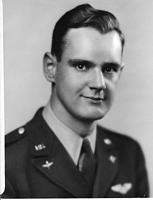 WALCH |
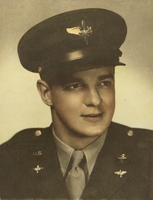 GRIM |
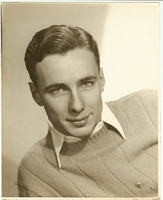 FOX |
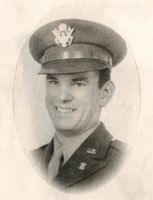 WALLACE |
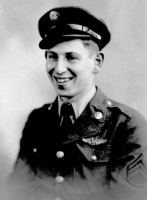 MENDOZA |
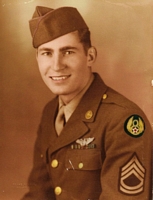 SMITH |
 DRAKE |
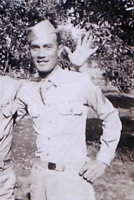 VINCENT |
 LATECKI |
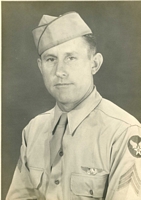 WILLIAMSON |
Following the crash, the pilots, 2/Lt.’s Walch and Grim, walked
down the mountain to seek help. 2/Lt’s Fox and Wallace
were killed in the crash of the aircraft while Sgt. Latecki
would succumb to his injuries four days later in hospital.
The surviving crew men suffered serious injuries. Local
people from the homes below the mountain hurried to the crash to
provide assistance to the aircraft's crew, being joined later by
personnel from nearby Irish Army barracks. After many
hours of struggling, the six injured men were taken down the
mountain and brought to Sligo County Hospital. All
survivors were later taken across to Northern Ireland.
Robert A Smith records that he finished his training at Kearney
Army Air Field in Nebraska. This was in late 1943 and a
base where B-17's and their crews were prepared for ferrying to
the European theater of operations. It is noted below that
crew members Emil C Drake and Adam J Latecki are recorded as
being members of a training squadron at that base. The
crew would have gathered at Kearney to complete training as a
crew having each completed their individual training courses
across America. They started their flight to Newfoundland from
Kearney and the ill fated flight to Europe. Carl W
Williamson in a postcard to his wife stated that he was enroute
to Moses Lake in Washington in August 1943. The crew may
have been placed together at this base, home of the 396th Bomb
Group (Heavy) which was a replacement training unit for B-17
crews at that time.
The following biographies discuss the ten members of the crew.
2/Lt Richard C WALCH O-745025 – Pilot
 Richard Clemens Walch
enlisted in the USAAF in March 1942. Coming from Hennepin
County, Minnesota, he is mentioned in his local newspapers
during 1942 as being an aviation cadet at CAl-Aero
Academy. His engagement was announced in August 1942 while
he was on a furlough from Santa Anna, California. His
appointment as a Second Lieutenant was published in Jun 1943 at
which time he was flying at Douglas, Arizona.
Richard Clemens Walch
enlisted in the USAAF in March 1942. Coming from Hennepin
County, Minnesota, he is mentioned in his local newspapers
during 1942 as being an aviation cadet at CAl-Aero
Academy. His engagement was announced in August 1942 while
he was on a furlough from Santa Anna, California. His
appointment as a Second Lieutenant was published in Jun 1943 at
which time he was flying at Douglas, Arizona.
2/Lt. Walch along with 2/Lt. Grim went off down the mountain
after the crash in an effort to seek help. Both had
suffered serious injuries but were the survivors best able to
move. Richard recovered from the injuries received in the
crash and went on to flying C-47 Skytrain aircraft in the
transport role. He is recorded as being a VIP pilot for
General Hugh J Knerr, the wartime head of Service Command in
Eighth Air Force and later for both Eighth and Ninth Air
Forces. A former crewmate, John F Gray recalled in 2009:
“As I was saying, after completing
my missions with the 379th bomb Group, I was assigned as the
radio operator on the B-17 that was converted to a luxury
passenger plane. The co-pilot was Richard C (Dick) Walch (we
started with a C-47). One of the special flights was one on
which we took FDR aide Harry Hopkins from Paris to Naples on
his way to meet Roosevelt for their Big Three Meeting
in Yalta in February of '45. We came back to WRIGHT FIELD in
Dayton, Ohio in August of '45. I was discharged in Nov. of
'45 and never heard from Walch again.”
"Mostly we were together only when we
were flying.... On the ground, officers and
enlisted men had separate quarters . The pilot, Jack Black
and Dick , stayed in officers quarters and Larry Ware and I
stayed in a room at the air field with the plane."
Richard's older brother, 1st/Lt Henry H Walch, was killed on 25
February 1945 when the B-26 Marauder bomber he was crew member
on crashed with another bomber from the 587th Bomber Squadron,
394th Bomber Group, Medium. He was initially interred in
France but in 1948 his remains were returned to Minnesota.
Their sister Jane served in the US Navy WAVES during the war.
Richard's son, Richard H Walch, like his father served in the US
Armed Forces but was sadly killed in a training accident in
November 1990.
Richard passed away in September 1987 in Hopkins,
Minnesota. He is buried in Fort Snelling National cemetery
in South Minneapolis. He is fondly remembered by his
daughters Barbara and Susan, his grand-daughter Kari as well as
his many grand children.
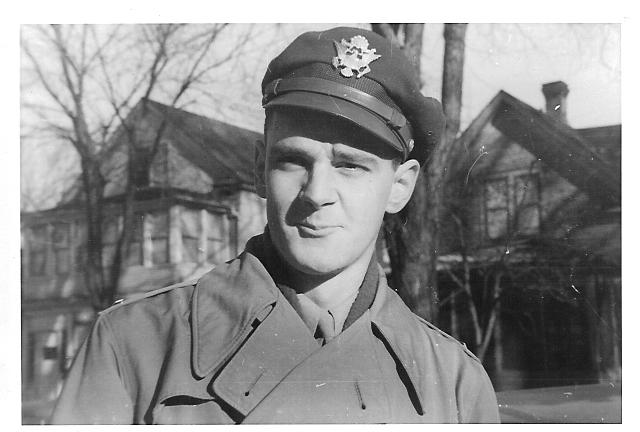
2/Lt William M GRIM O-751123 – Co-Pilot
 Enlisting in March 1942,
William Grim came from Greensburg, Pennslyvania.
Enlisting in March 1942,
William Grim came from Greensburg, Pennslyvania.
The Daily Courier of Connelsville, PA on December 21st, 1943
Carried the following news story:
“Lost in Atlantic, Found.
GREENSBURG, Dec. 21. Lieutenant William M. Grim,
28, feared lost during a flight over the North Atlantic, has
been found his parents have advised by the War
Department. The former football star was accidentally
injured but there were no other particulars.”
William married his sweetheart Ethel in February 1946 and the
Daily Courier carried a large article describing their candlelit
ceremony.
William Grim remained in the Air Force after the war finally
retiring in 1970. He passed away in Texas in 1994.
He left behind a report which he prepared in conjunction with
Moss Mendoza and this has been transcribed by his daughter
Gretchen and is presented after this list of names.
In the US NARA archives, a copy of a transcription of the events
2/Lt Grim exists. It reports that it was he and 2/Lt
Walch that went down the mountain from the crash site to seek
help. The hand writing of the intelligence officer sadly
makes it difficult to read the report, expected to date from mid
May 1944. Spelling is as presented in the report.
“Dec. 9th 1943 -
North East SLIGO (EIRA) hit a mountain side -
The pilot and I went for a rescue team.-
24 hours in Irish Hospital in Sligo.
From there moved to the 28th Station Hospital (near
ENNISKILN) There 24 hrs.
Then moved me to 79th General Hospital (outside
Marowe). In bed for about 2 months, -
Could get up and walk after a while. (Got a 10
day went Kings-cliff, Edenborough and Glasgow) Released me
on the 13th flew to Prestwick and took train here.”
Kingscliff, Edinburgh and Glasgow of course are all places in
Scotland. 79th General Hospital had been set up at
Waringfield Hospital in November 1943. This was located in
Moira, in County Down in Northern Ireland.
2/Lt Richard E FOX O-685794 – Bombardier
 Son of Oscar and Alma
Fox of Fort Wayne, Indiana. Richard was born in April 1919
and enlisted in the armed forces in November 1941. His
remains were initially buried in the US Plot of Brookwood
cemetery in Surrey, England but were returned to Indiana after
the war.
Son of Oscar and Alma
Fox of Fort Wayne, Indiana. Richard was born in April 1919
and enlisted in the armed forces in November 1941. His
remains were initially buried in the US Plot of Brookwood
cemetery in Surrey, England but were returned to Indiana after
the war.
The National Archives and Records Administration, war Department
Files record him as:
2 LT Richard E. Fox
ID: O-685794
Branch of Service: U.S. Army
Hometown: Allen County, IN
Status: Died Non Battle
A photograph and obituary for Richard E fox received from his
niece Trish.
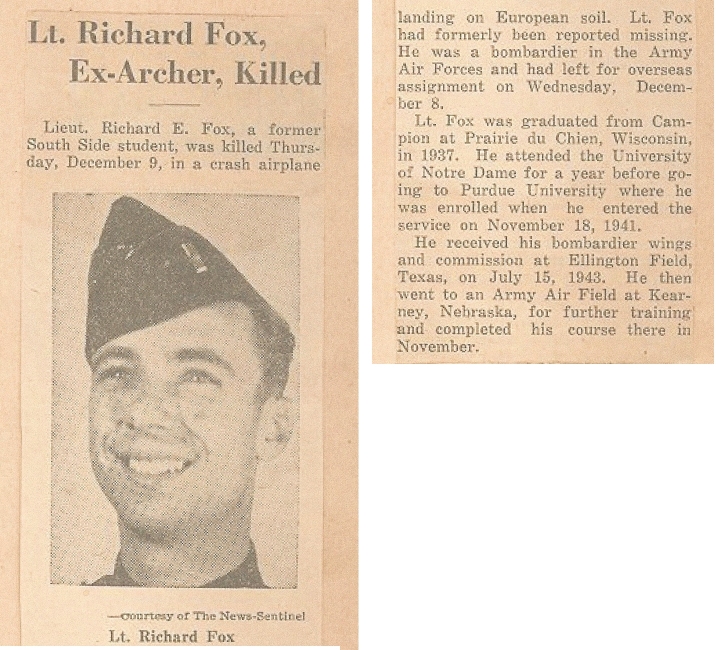
Richards remains were returned to his native Indiana in 1948 and
interred in the family plot in the Fort Wayne Catholic Cemetery.
2/Lt William Francis WALLACE O-1573651 – Navigator
 Son of Daniel
and Katherine Wallace of Hoboken New Jersey.
Son of Daniel
and Katherine Wallace of Hoboken New Jersey.
William F Wallace entered the service from Hudson County, New
Jersey.
Tragically the family would loose three sons to the war,
William's brothers Daniel J and James M both died in air
accidents with the US Navy. The three brothers name's
appear at the bottom of the Hoboken War Memorial. The
local Wallace Primary School is named in their honour.
Both his brothers died before William. Their father,
Daniel Wallace, died in 1948 leaving instruction that his son
William was to remain buried overseas so as not to disturb his
remains. They were survived by Williams sister Catherine
only and their aunts, uncles and cousins. Catherine died
in 1987 having lived in care all her life, having been born it
appears with special needs.
His remains were initially buried in the US Plot of Brookwood
cemetery in Surrey on the 18th of December along with Fox and
Latecki but upon his fathers instructions he now lies buried in
American Battle Monuments Cemetery at Cambridge and they record
him as follows:
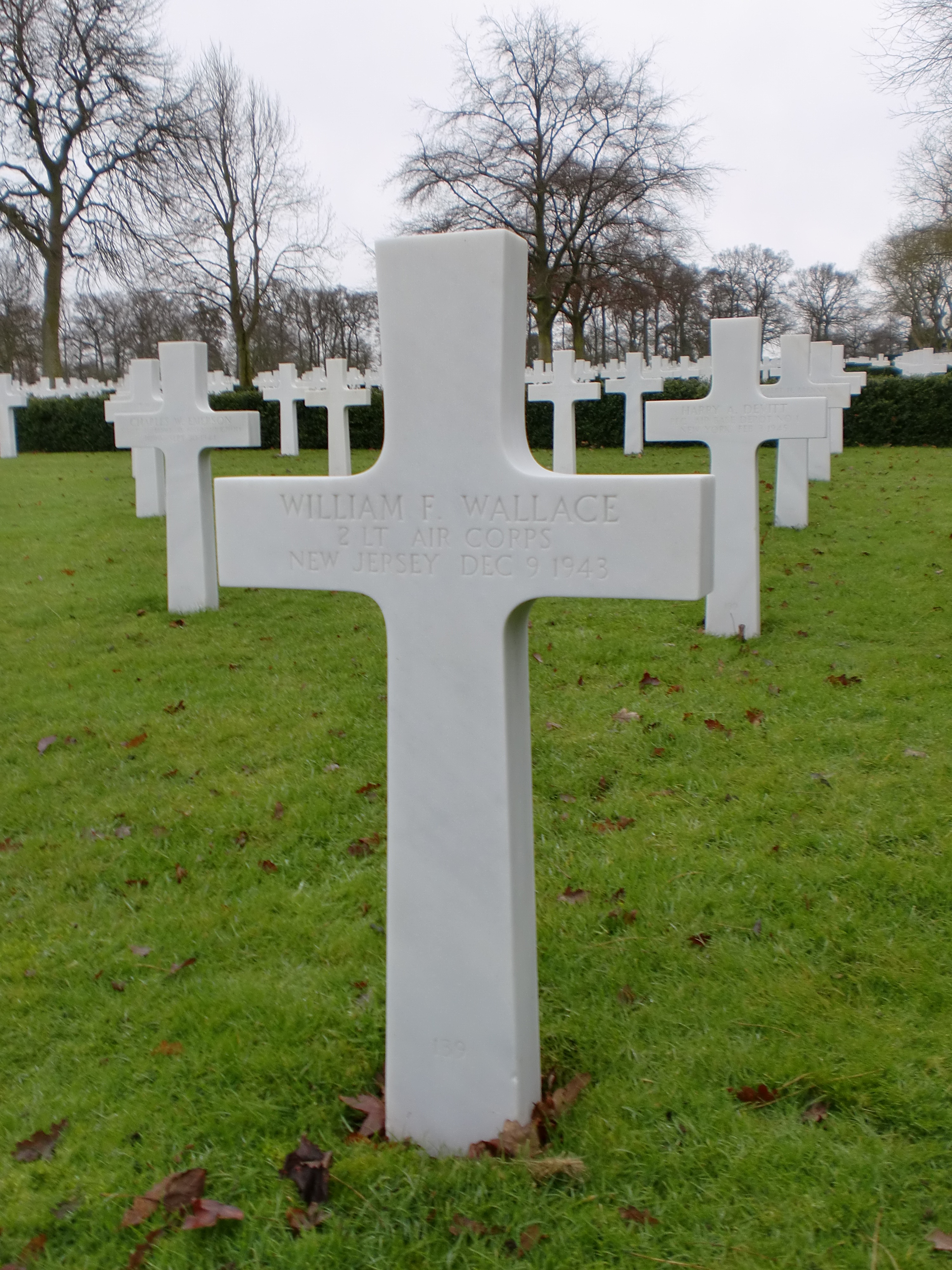 William
F. Wallace
William
F. Wallace
Second Lieutenant, U.S. Army Air Forces
Service # O1573651
Army Air Corps
Entered the Service from: New Jersey
Died: 9-Dec-43
Buried at: Plot F Row 5 Grave 139
Cambridge American Cemetery, Cambridge, England
The National Archives and Records Administration, war Department
Files record him as:
2 LT William F. Wallace
ID: 01573651
Branch of Service: U.S. Army
Hometown: Hudson County, NJ
Status: Died Non Battle
The New York Times of April 7, 1943 carried a story relating
that a James M Wallace of Hoboken, New Jersey was feared killed
in a Naval aircraft crash. It reported that he had two
brothers as mentioned above and that his father, Daniel Wallace
was Plumbing Commissioner for the City. They lived at
Bloomfield Street, Hoboken, the same address they can be found
at in the 1930 census. Their cousin, a William Goode,
remembered them on the World War Two Memorial Website.
Their cousin Patty LaSorsa very kindly provided the photograph
of William.
This collection of information about 2/Lt. Wallace is built up
using ABMC information above and his Individual Deceased Persons
File from the US Army Archives. The only William F Wallace
enlistment to fit the ABMC data and the NARA information is for
William F Wallace born in 1918 and enlisted in August 1941.
The family were able to provide the following newspaper
cutting.
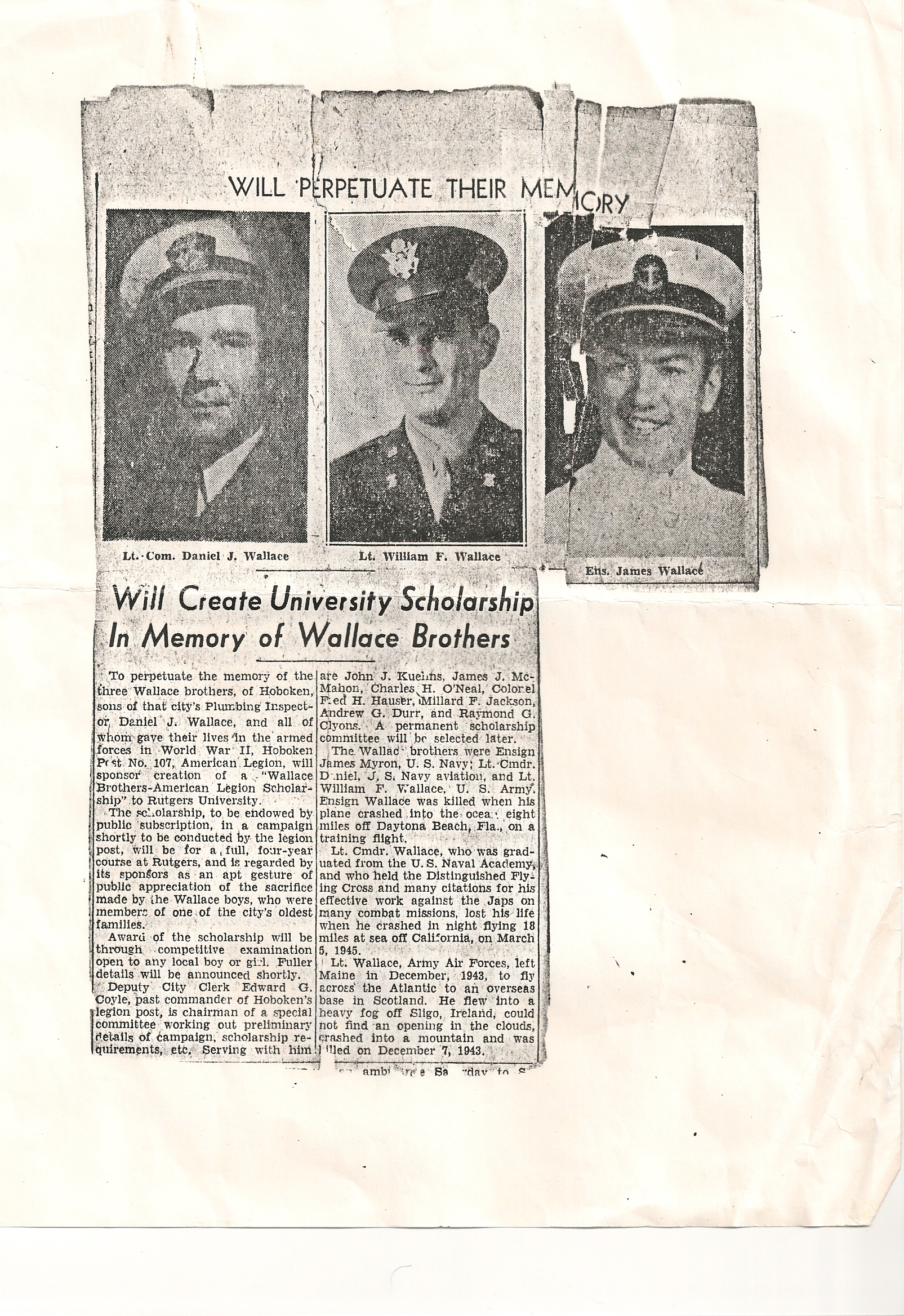
And their fathers obituary from 1948.
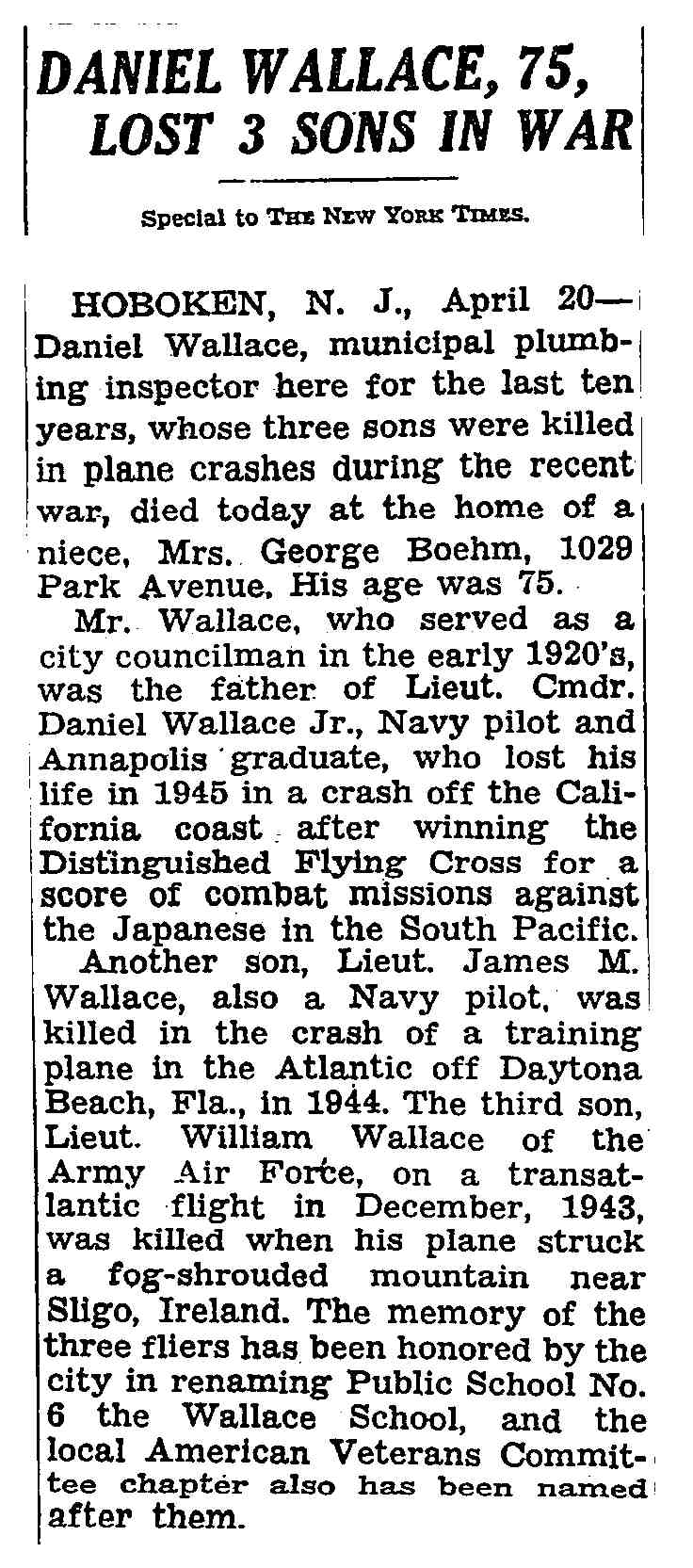
The Wallace School was sold in 1972 and replaced a new building
which remains in 2024, the Wallace Elementary School, on Willow
Avenue and 11th Street, Hoboken. Photos of the three
brothers hang in the lobby of the school.
S/Sgt Moss L MENDOZA 11114403 – Engineer
 Moss L Mendoza enlisted in the Air Force in
October 1942 in Boston. He was born in 1923, son of
Florence and Judah Mendoza.
Moss L Mendoza enlisted in the Air Force in
October 1942 in Boston. He was born in 1923, son of
Florence and Judah Mendoza.
Moss was seriously injured in the crash. Shipping records
show that he arrived back in New York on December 18, 1945,
sailing on the Queen Mary. His name is recorded in error
on the manifest as Maurice but the serial number is his.
His military occupation is given as Air Gunner. He sailed
home attached to the personnel of Army Air Force Station 595 at
Troston, Suffolk, England.
Moss married in January 1946 after the war. Moss’s
daughter Roberta remembers that Moss served in the Air Force
Reserves after the war up until they moved to Florida.
Moss worked as a butcher for most of his post war career.
He worked for a large Furniture Store and was a sales manager
until he had to stop working when he got ill. That was
around 1982 or 1983. His grandson was born in December
1984 and was the love of Moss’s life.
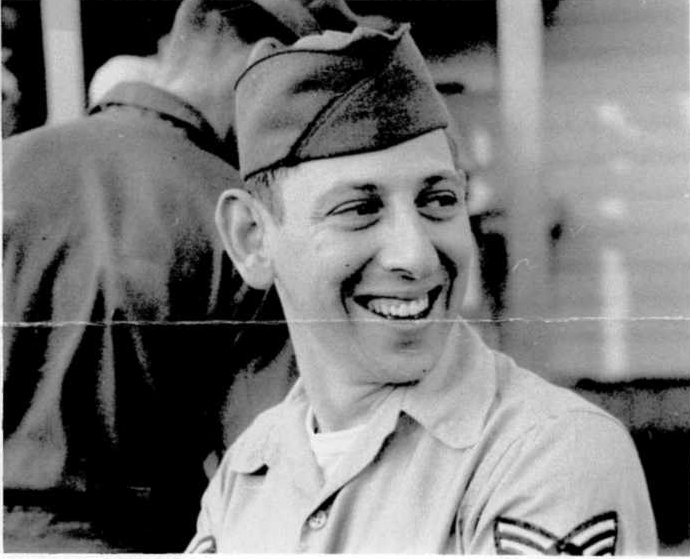
The above photo from Moss’s albums was taken post war while
serving with the Air Force Reserve at Otis Air Force Base in
Massachusetts.
Moss sadly passed away in Florida in 2002. He is remembered fondly by his daughter Roberta and his brother Jack, who also flew during the war with the US Navy.
S/Sgt Robert A SMITH 18192259 - Radio Operator
 Robert
Alexander Smith, or Bob Smith, recovered from his injuries
received in the Sligo crash and would go on to see action over
Europe with the 527th Bomb Squadron of the 379th Bomb Group.
Robert
Alexander Smith, or Bob Smith, recovered from his injuries
received in the Sligo crash and would go on to see action over
Europe with the 527th Bomb Squadron of the 379th Bomb Group.
Bob was the son of Emmett and Imo Smith from Chandler,
Oklahoma. At the time of his register for the draft in
1942, he was still resident at home with his parents on the
family farm.
Robert A Smith contacted me in January 2006 through the
assistance of the 379th Bomb Group Association. Bob lived
in Washington and was interviewed by local radio in Northern
Ireland during that year.
Robert, or Bob as he went by, gave this account of his war time
service to the 8th Air Force Database Website:
“Worst trip on June
25, 1944 much flak and fighters. Was in A/C 890 (listed in
Shades of Kimbolton). Bombed bridge at Suryonne, France. On
the way back we took a direct hit, which took off chin
turret. Two in-board engines out and severe vibration.
Bombardier Lt. Maatta Arthur was killed.
Co-Pilot Lt. Pat Rawls said, all that can, better bail
out, so Navigator, Lt. Robert Evans (Tail Gunner), S/Sgt.
Joe Simoncini and (Waist Gunner), S/Sgt Francis Phillips all
jumped, but were shot on way down and killed according to
Major Alec Andrews, who was observer on that trip.
1st Lt. Karl Becker decided he would try to fly it
back since Lt. Maatta couldn't jump (both legs gone). We
made it to a British Night-Fighter Base on coast. T/Sgt.
Geo. Brittain was Engineer and Top Turret Gunner, who tried
to helped save Maatta and to lighten the load, etc. Major
Andrews put him in for the Silver Star. On way to Prestwick,
Scotland from Goose Bay, Labrador, we crashed (in fog) in
Sligo Mountains, South Ireland on December 9, 1943 in A/C
#42-31420. Navigator, Bombardier and Waist Gunner were
killed. The rest of us were in pretty bad shape. I was
luckiest with broken jaw and cracked shoulder after RAF got
us out of South Ireland. They got me ready to fly by May,
1944 and flew with Becker's crew on "Lucky Lucy" until they
finished. Then was used as Lead Radio-Operator until
finishing tour. In 1945 I went to CBI and got in 650 hours
flying the "Hump" until the "A" Bomb finished off Japan.”
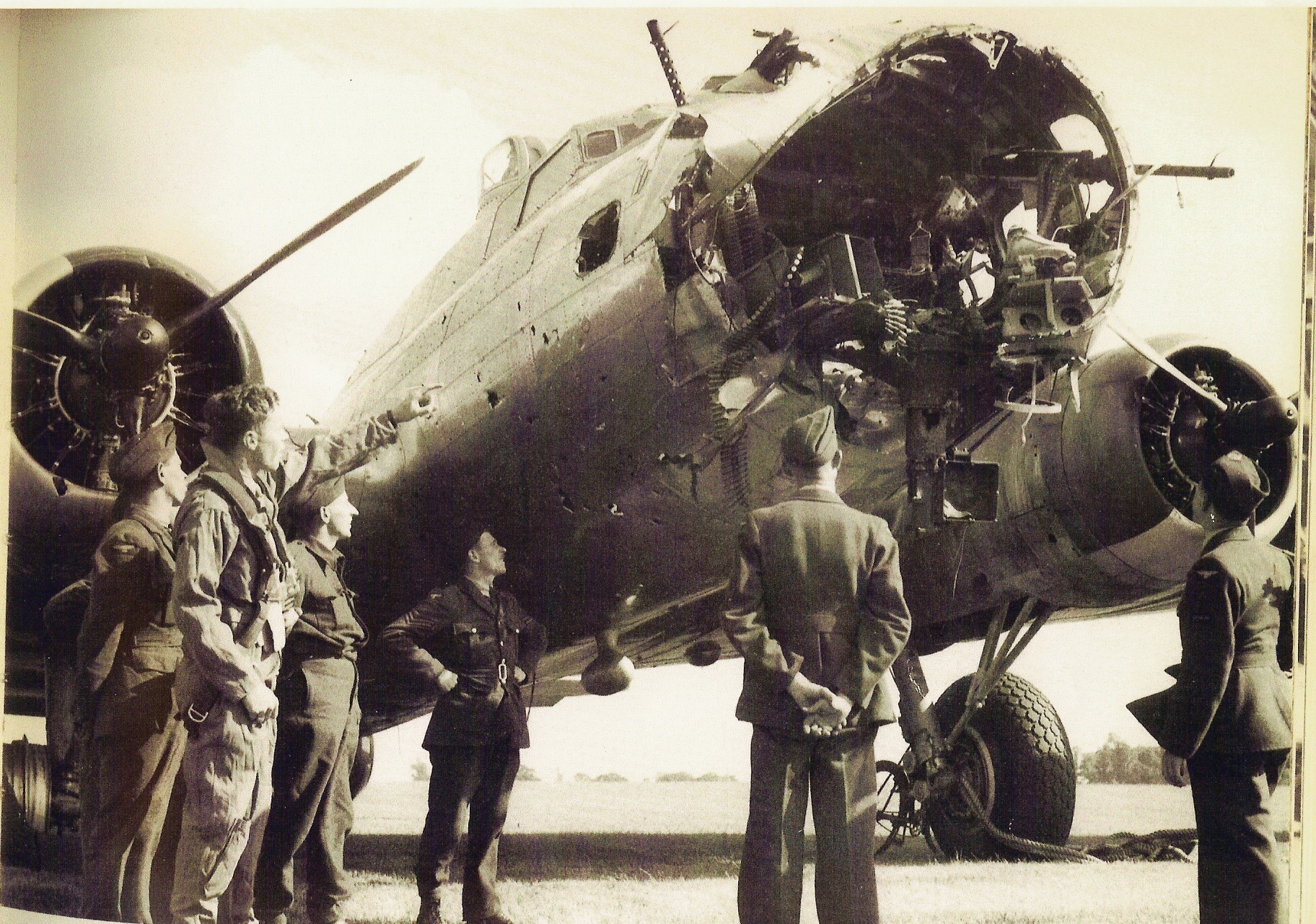
Bob and his son in law Donald Schulz were kind enough to send
this photo, above, showing the damage suffered by his aircraft,
B-17 42-97890, painted with nose art, Lil' Satan on June 25th
1944.
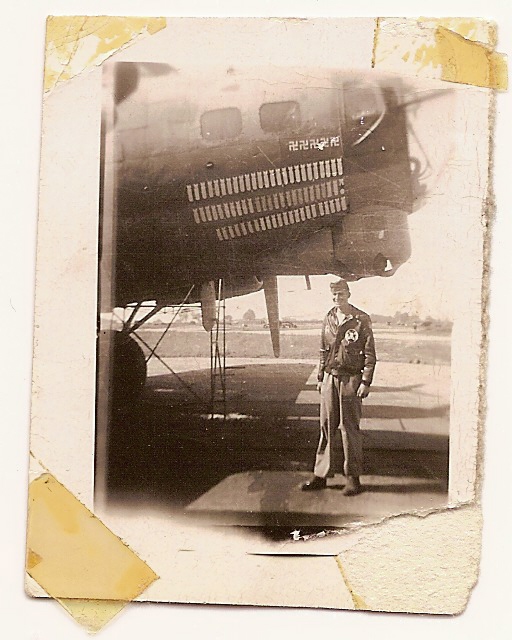
Bob is shown above standing below another of the aircraft he
flew and fought on, Carol Dawn.
A local Sligo man, Sean Gallagher, was 7 years old at the time
of the crash. Bob tells how that in 1959 Sean went up to
the crash sight when he was visiting relatives. He lived
in Brooklyn, New York in 1959. He found Bob's dog tag at
the crash site in 1959. Somehow he got Bob's home address
in 1943 and sent the tag and letter to him there. Bob had
moved to Washington then so it sat in the 'dead letter office'
for a time until someone recognized Bob's name and got it mailed
to him in Washington.
Bob last met a crew member, Richard Walch, at Bob's wedding in
1947 in Minneapolis. He was the proud father of six
children and 26 grandchildren. Bob passed away in December
2016 and lies buried in Tahoma National Cemetery, Washington.
Sgt Adam J LATECKI 16144885 – Gunner
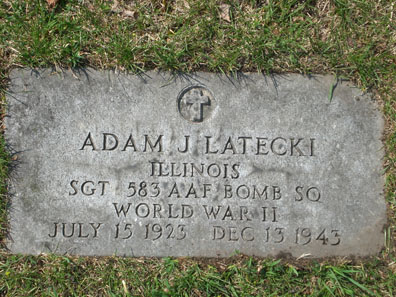 Adam J Latecki enlisted in October 1942 in
Chicago. Born in July 1923, he was son of Stephen and Mary
Latecki of Chicago, both of whom were immigrants from Russia and
Poland. Adam's father was a tailor and died in January
1931. His mother remarried in 1937 and in 1943 was Mary
Stopa, Adam's step father being Philip Stopa. Adam had one
sister born in 1930 named Mary but she passed away in
1987. Sgt. Latecki survived the crash but died from his
injuries on December 13th at the 28th Station Hospital at
Irvinestown in Northern Ireland. Janice Colvin of Chicago,
kindly provided this photo of his headstone in April 2010.
His mother lived at 1537 South Harding Avenue, Chicago and an
aunt, Rose Parada living at 2456 North Long Avenue.
Adam J Latecki enlisted in October 1942 in
Chicago. Born in July 1923, he was son of Stephen and Mary
Latecki of Chicago, both of whom were immigrants from Russia and
Poland. Adam's father was a tailor and died in January
1931. His mother remarried in 1937 and in 1943 was Mary
Stopa, Adam's step father being Philip Stopa. Adam had one
sister born in 1930 named Mary but she passed away in
1987. Sgt. Latecki survived the crash but died from his
injuries on December 13th at the 28th Station Hospital at
Irvinestown in Northern Ireland. Janice Colvin of Chicago,
kindly provided this photo of his headstone in April 2010.
His mother lived at 1537 South Harding Avenue, Chicago and an
aunt, Rose Parada living at 2456 North Long Avenue.
The National Archives and Records Administration, war Department
Files record him as:
SGT Adam J. Latecki
ID: 16144885
Branch of Service: U.S. Army
Hometown: Cook County, IL
Status: Died Non Battle
He was first buried at on December 18th, 1943 in Brookwood
cemetery in Surrey, England. He was buried in the grave
next to Richard E Fox. In the next grave was buried Sgt.
Earl L Bir who died on December 9th in the other B-17 crash in
Northern Ireland. In 1946, Adam's mother began the process of
having her sons remains returned to her in line with government
policy at the time. In a letter dated of April 1946 to the
US War department, Mary Stopa asks the Army to let her her know
where her son was buried. Finally, in the summer of 1948,
Sgt. Latecki's remains were disinterred and returned to Chicago
where his mother had arranged for him to be buried in St.
Adalberts Cemetery in the city. His head stone was ordered
to read:
ADAM J LATECKI
ILLINOIS
SGT 583 AAF BOMB SQ
WORLD WAR II
JULY 15 1923 DEC 13 1943
The 583rd Heavy Bomber Squadron, one of the Squadrons in the
393rd Bomb Group, a Replacement Training Unit, was located at
Sioux City Army Air Base in Iowa from November 7, 1943 to April
1, 1944. The unit was not sent to a combat theatre but was based
at Kearney Army Air Forces Field between August and November
1943.
Sgt Wilfred N VINCENT 34150978 – Gunner
 Wilfred Vincent enlisted in Camp Shelby,
Mississippi in September 1941. Born in late in 1917 in St
Charles Parish, Louisiana. Census records from 1920, 1930
and 1940, show that he lived with Hattie and Louis Wilford
Ganier, in new Orleans and Baton Rouge. On those records
he is variously described as nephew or adopted son of the
couple. In October 1940, he registered for the draft,
being at the time resident with the Ganier's and employed in
Baton Rouge. He was working in a Tile Shop at that
time. He registered under the name Wilfred Norrill Ganier
Vincent and named his father, Charles Vincent in New Orleans as
his next of kin. He was described as Italian/Indian on his
registration card.
Wilfred Vincent enlisted in Camp Shelby,
Mississippi in September 1941. Born in late in 1917 in St
Charles Parish, Louisiana. Census records from 1920, 1930
and 1940, show that he lived with Hattie and Louis Wilford
Ganier, in new Orleans and Baton Rouge. On those records
he is variously described as nephew or adopted son of the
couple. In October 1940, he registered for the draft,
being at the time resident with the Ganier's and employed in
Baton Rouge. He was working in a Tile Shop at that
time. He registered under the name Wilfred Norrill Ganier
Vincent and named his father, Charles Vincent in New Orleans as
his next of kin. He was described as Italian/Indian on his
registration card.
Shipping records show him flying from Prestwick, Scotland to New
York on the 10th May 1944 as a passenger on a USAAF Douglas C-54
transport aircraft. He was discharged from military
service following the crash, due to the nature and extent of his
injuries. He returned to his home after the war and and
opened a tile-setting business, which he ran for many years
until his retirement. His family recall that he tried for
many years to contact his former crew mate and may have
contacted one who lived in Florida. He was under the
impression that seven of them had died in the accident.
Wilfred passed away in April 1998 and is buried in Biloxi National Cemetery alongside his wife Wilhelmina. He was at the time of his death resident in Ocean Springs, Mississippi. His birth parents are named as Charley Valencino and Louise Ernest on his social security records.
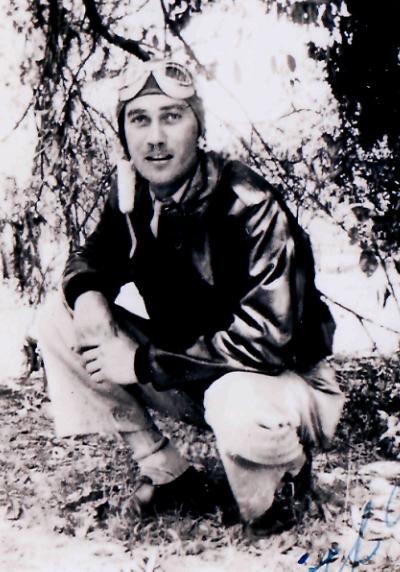
Sgt Emil C DRAKE 15325547 – Gunner
Sgt Emil C. Drake was born in Pettigrew, Arkansas in 1908.
His parents were Columbus Drake and Mary E "Nannie or Nan"
Fletcher. Research reveals Emil’s father was a member of
the US Army in early part of the century and enlisted with the
Canadian Army in 1915 but deserted some days later. his
local newspaper reported on his death however on 21st October,
1916, serving in France with the 75th Canadian Infantry
Battalion. No one of that name is recorded in British
Commonwealth records, however the records of one Sergeant John
Kendall Hume 163964 reveal that Emil's father, having deserted
in march 1915, reenlisted again in August 1915 under the name
John Kendall Hume, pension records in the file revealing the
truth.
Emil enlisted in the Army on 23 September 1942 in Louisville,
Kentucky.
The 1930 census shows him living in Gray, White County and
working a Clerk in a Mens Store. In 1937 he was recorded
in newspapers as the Manager of Montgomery Ward Store in Poplar
Bluff, Missouri. His draft registration form dated October
1940 places him living in Chandler Avenue, Evansville, Indiana
where he was this time in the Evansville Montgomery Ward
store. Emil enlisted in Kentucky in September 1942.
The Northwest Arkansas Times in 1943 – 1944 recorded some of
Emil’s recovery from injury. The paper on December 14,
1943 reported that his mother had received word on Friday
December 10th from the C/O of the North Atlantic Wing at
Presque Isle that her son was missing. By December 22nd
she had been informed that he was in fact seriously
injured. Further on the 26th January it was reported that
Emil was somewhere in Ireland undergoing treatment. Some
months later on 2nd June they reported that he had been
transferred to a New York hospital for further treatment.
On October 3rd, 1944, the paper reports that ‘Mrs Nan Drake has
had as her guest from the Army-Navy hospital in Hot Springs her
son, Sgt Stanley Drake’. It is thought that this refers to
Emil. The Times newspaper of Fort Smith, Arkansas on
October 14, 1945 published the following article:
Survivor of Bomber Crash Visits
Springdale
Springdale, Ark .- (Special) -Sergeant Emil C.
Drake, who suffered a fractured skull, a crushed
ankle and five broken ribs in a
bomber crash two years ago in Ireland, has
received his discharge and is visiting his
mother. Mrs. Nan Drake, who has lived with
her aunt, Mrs. J. H. Fletcher, in Springdale
the last two years.
Sergeant Drake had been in the Beaumont
hospital at El Paso, Texas, the last 22
months. The bomber was en route from Labrador
to England at the time of the crash in which
four members of the crew were killed. Drake
was taken to the United States from England
and received plastic surgery at Beaumont hospital.
After his visit here, he will go to California
where he will be employed.
Having survived the crash in Ireland, Emil and his mother would
tragically loose their lives in a motor vehicle accident in
1949:
Kingsport News - February 1, 1949, Kingsport, Tennessee
Tennessee's death toll resulting from
winter's first prolonged blast at the Southland rose to four
Monday night when a car and a Greyhound bus collided near
Rutherford, Tenn. Highway patrolmen said Mrs. Mamie Drake
and her son. Emil Drake of Evanston. Ill., were killed in
the wreck. The icy road, Highway 45-W, was blamed for the
collision.
Northwest Arkansas Times - February 4, 1949, Fayetteville,
Arkansas
Word has been received here by Mrs.
Ella Fletcher and Mrs. Betty Searcy of the death of Mrs. Nan
Drake and her son, Emil Drake. The two were killed in
an accident while enroute to Evansville, Ind., where they
were residing. The bodies are being returned to Searcy
for burial. Mrs. Drake was a cousin of Mrs. Betty
Searcy of Springdale and a niece of the late J. H. Fletcher
of Springdale. She spent some time in Springdale while
her son was recovering from an airplane accident in which he
was seriously injured during the war.
They are buried at the Oak Grove Cemetery in Searcy,
Arkansas. A transcription of Emil's headstone on
www.rootsweb.com records:
Drake, Emil C., Sgt. January 05, 1908
January 31, 1949
Son of Nannie E. Drake; Ind., 583rd H.B. Squad, WWII
Drake, Nannie E. December 16, 1887 January 31, 1949
The 583rd Heavy Bomber Squadron, was the same unit that was
listed on Adam Latecki's headstone.
Sgt Carl W WILLIAMSON 18162726 - Gunner
 Carl W Williamson came from Okmulgee, Oklahoma,
son of Barnett and Emily Williamson. Born in 1909, he
enlisted in the air force in November 1942. His local
newspapers in Oklahoma, reported in the summer of that he had
completed a aircraft mechanics course at Sheppard Field, Texas
and that he was being posted to California. The Okmulgee
Daily Times on Nov 6, 1943 reported that: Sgt. and Mrs Carl Williamson, Kearney, Neb.,
are the guests of Sgt. Williamson's parents, Mr. and Mrs.
Williamson, Henryetta Road. Kearney of
course was where the crew came together.
Carl W Williamson came from Okmulgee, Oklahoma,
son of Barnett and Emily Williamson. Born in 1909, he
enlisted in the air force in November 1942. His local
newspapers in Oklahoma, reported in the summer of that he had
completed a aircraft mechanics course at Sheppard Field, Texas
and that he was being posted to California. The Okmulgee
Daily Times on Nov 6, 1943 reported that: Sgt. and Mrs Carl Williamson, Kearney, Neb.,
are the guests of Sgt. Williamson's parents, Mr. and Mrs.
Williamson, Henryetta Road. Kearney of
course was where the crew came together.
Similar to the other crew members, their local papers reported
that word had been received by next of kin that they were
missing in action, in Carl's case the Okmulgee Daily Times
published his missing note on December 14th. December 21st
however brought the good news that he was safe and accounted for
"somewhere in the European Area".
He was mentioned in a newspaper article about fellow Oklahoma
crewmember, Robert Smith in the The Chandler News-Publicist on
Dec 23rd, 1943.
His son in law, Billy J Wells Sr and his daughter in law
Marilyn Wells were very helpful in this research by sending to
me items belonging to Carl from his war time
service. Bud, as he was known by all, was an all
star football player for the Okmulgee Bulldogs. He
attended college at Oklahoma A & M in Shawnee on a partial
scholarship where he played both football and baseball.
When he came home from college, he played baseball for Phillips
Petroleum Company and was later hired at the refinery. He
then went into the service.
Billy Wells Sr remembers Carl as:
“My first meeting with Sgt Williamson
was in 1944 at a military hospital in McKinney, Texas.
My wife, Huberta Wells, and I were on leave from NAS Whidbey
Island, Washington. Bud was in hospital bed with his
leg elevated to help relieve the swelling. Huberta and
I had spent 3 nights and 4 days on a steam train (cold and
dirty) travelling back to Texas where we were joined by
Madalyn, Buds wife and Huberta’s mother. Bud was
allowed to get out of bed where he joined me in a visiting
room at the hospital. I asked him what had
happened. He said the weather was very bad before the
crash but I also got the impression that he never knew they
were about to hit a mountain.
I remember that Bud and I sat on the patio talking
about our service experiences. He talked about the
plane crew but again that was a long time ago. Bud
enjoyed fishing, bowling and gardening as well as
woodworking. Not surprisingly he excelled at all of
that.
When the word gentleman was coined, Bud must have been
the model”
Shipping records show that Carl landed in New York as a
passenger on a military transport aircraft in May 1944. He
spent the rest of the war recovering from his injuries,
returning home in November 1945. His family still have his
1945 train tickets.
in 1950, The Okmulgee County News published an article about
employees of the Phillips Petroleum company, and included this
history of Bud's service:
Williamson came to Okmulgee as lube
plant operator shortly after he joined Phillips at Wetumka.
He also served here as controlman, Dubbs still and as safety
inspector. In 1950 he transferred to the company's Plains
butadiene plant at Borger, Texas assistant safety supervisor
and a short time later returned to the
Okmulgee refinery as director of equipment inspection and
safety. His present position is general maintenance
section supervisor.
Carl passed away in 1987, his obituary from the Okmulgee Daily
Times read: CARL WILLIAMSON Carl
William (Bud) Williamson, age 77, died in a local hospital
on Monday, January 5, (1987) after a long illness. Born
January 26, 1909 in Okmulgee, Mr. Williamson was a veteran
of the U.S. Army Air Corps. He was a member of the First
Christian Church, the Scottish Rite of the McAlester
Consistry, and was a 32nd Degree Mason in the Knights of
Templar. Survivors include his wife, Madalyn Williamson of
the home in Okmulgee; one daughter, Huberta Wells of Corpus
Christi, Texas; two sisters Nina Bailie of Okmulgee, and Peg
Mason of San Diego, California; two grandchildren, and two
great-grandchildren.
Items belonging to Carl ‘Bud’ Williamson which his family shared
with me. These items are presented here both to remember
Carl but also as they are relevant to all crew members. It
can be imagined that their loved ones, parents, wives received
such telegrams and postcards.
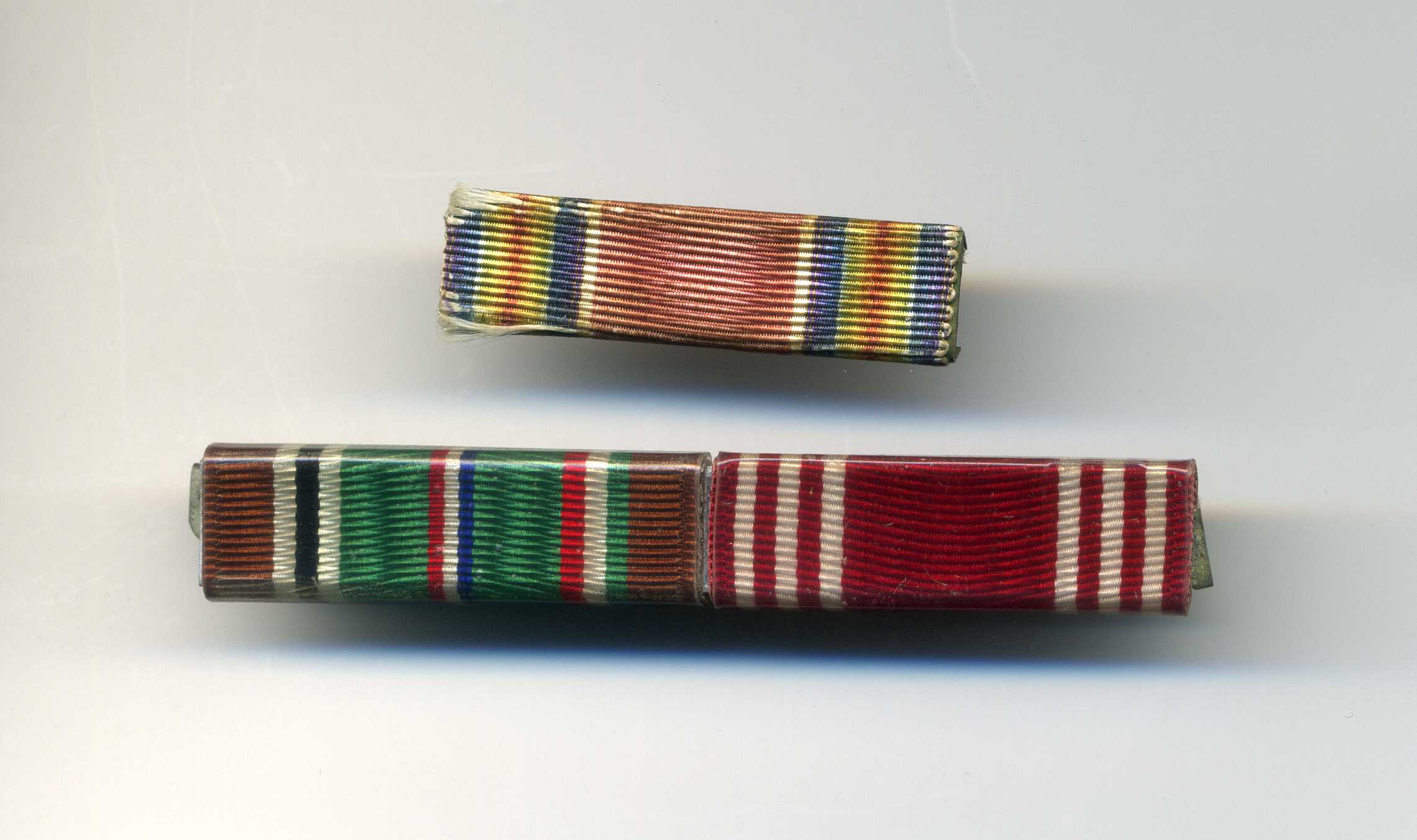 Carl’s
service ribbons. The upper is the World War II Victory
ribbon, the lower arrangement is the European-Africa- Middle
Eastern ribbon next too his red and white Good Conduct Ribbon.
Carl’s
service ribbons. The upper is the World War II Victory
ribbon, the lower arrangement is the European-Africa- Middle
Eastern ribbon next too his red and white Good Conduct Ribbon.
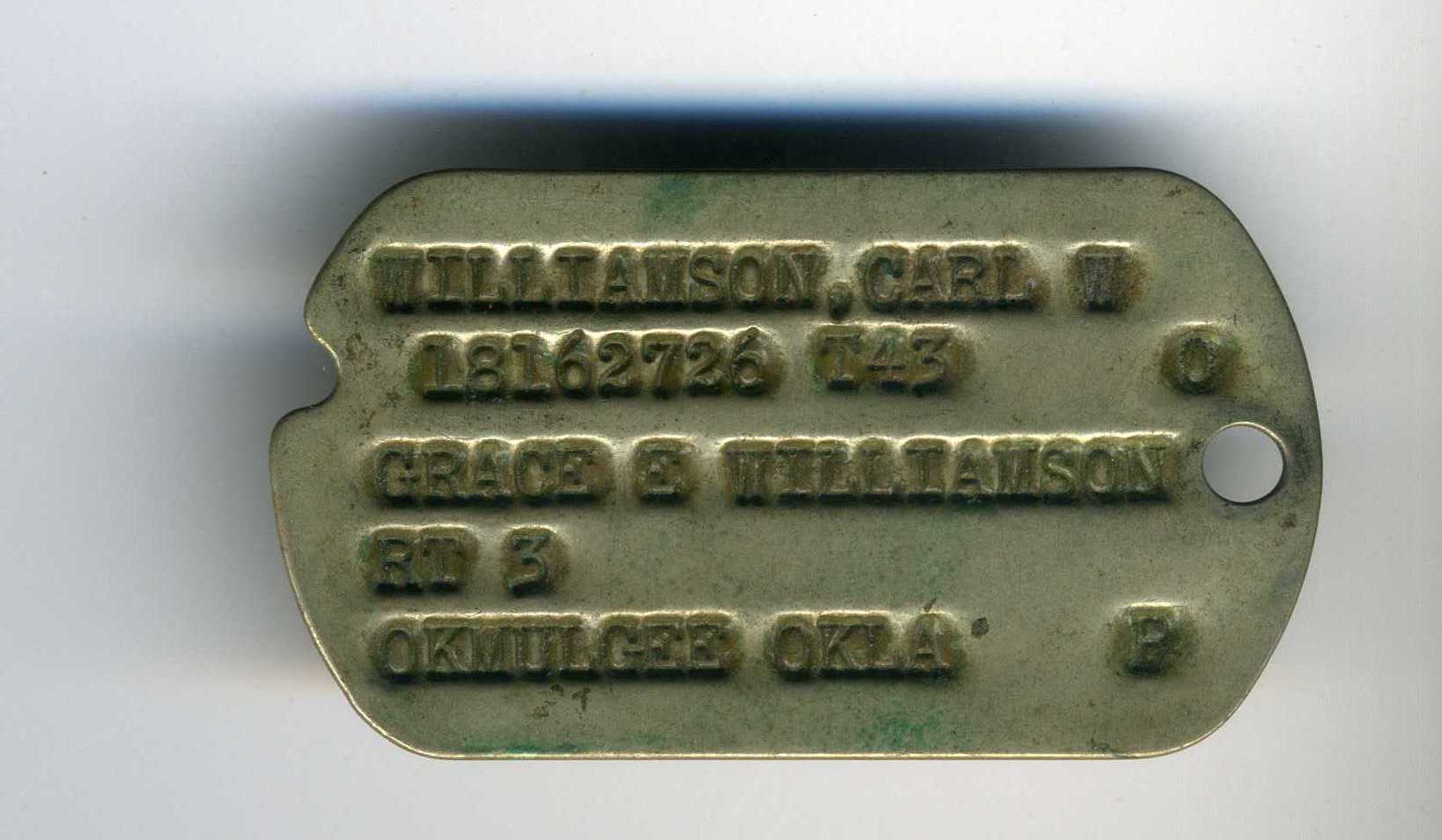 Carls identity tag, ‘Dog Tag’
Carls identity tag, ‘Dog Tag’
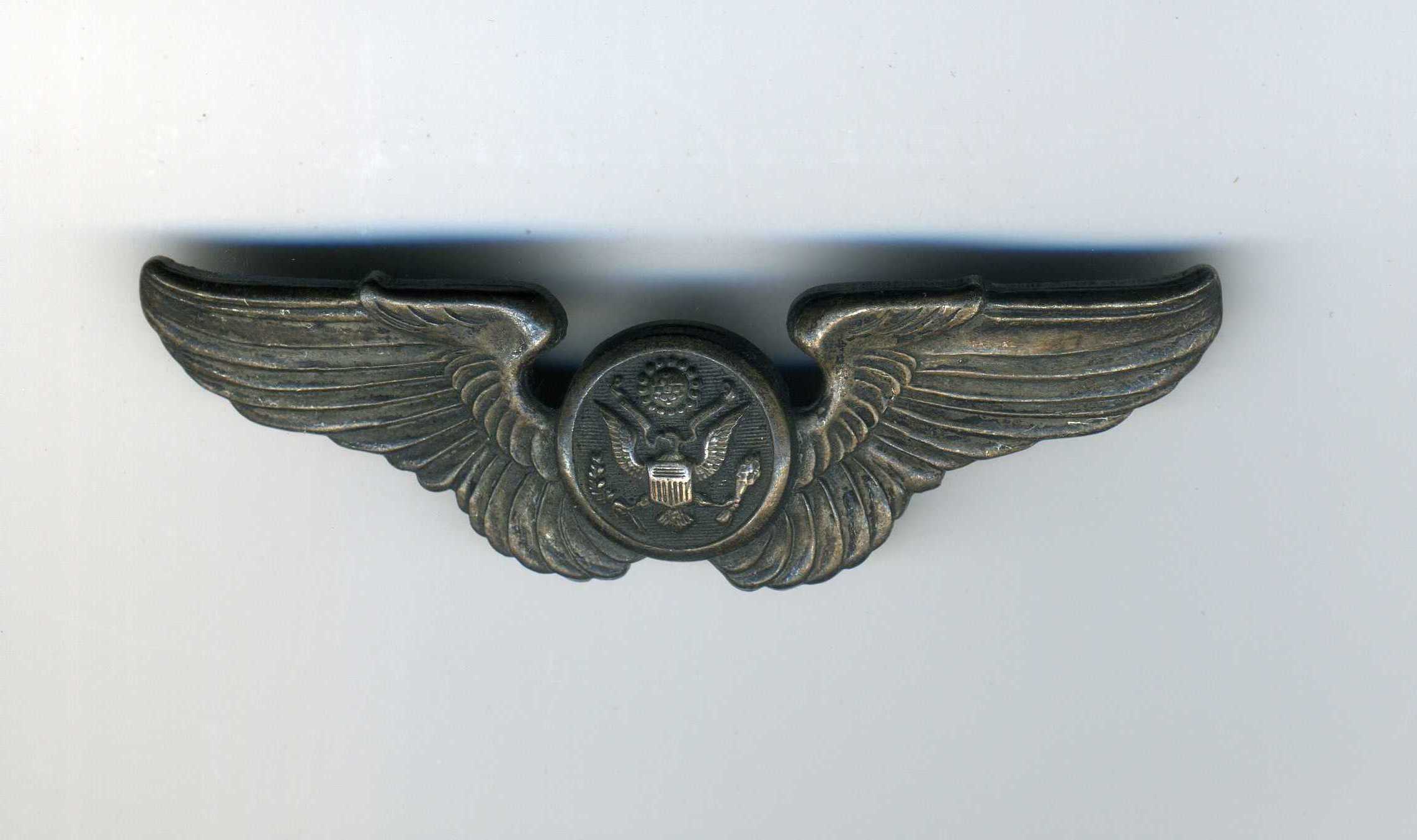 Carl’s Army Air Forces Aircrew
Badge. All aircrew members were authorized to wear this
badge upon completion of training.
Carl’s Army Air Forces Aircrew
Badge. All aircrew members were authorized to wear this
badge upon completion of training.
Below, copies of the telegrams received by Madalyn Williamson in
the days after the crash of 42-31420 in Ireland.
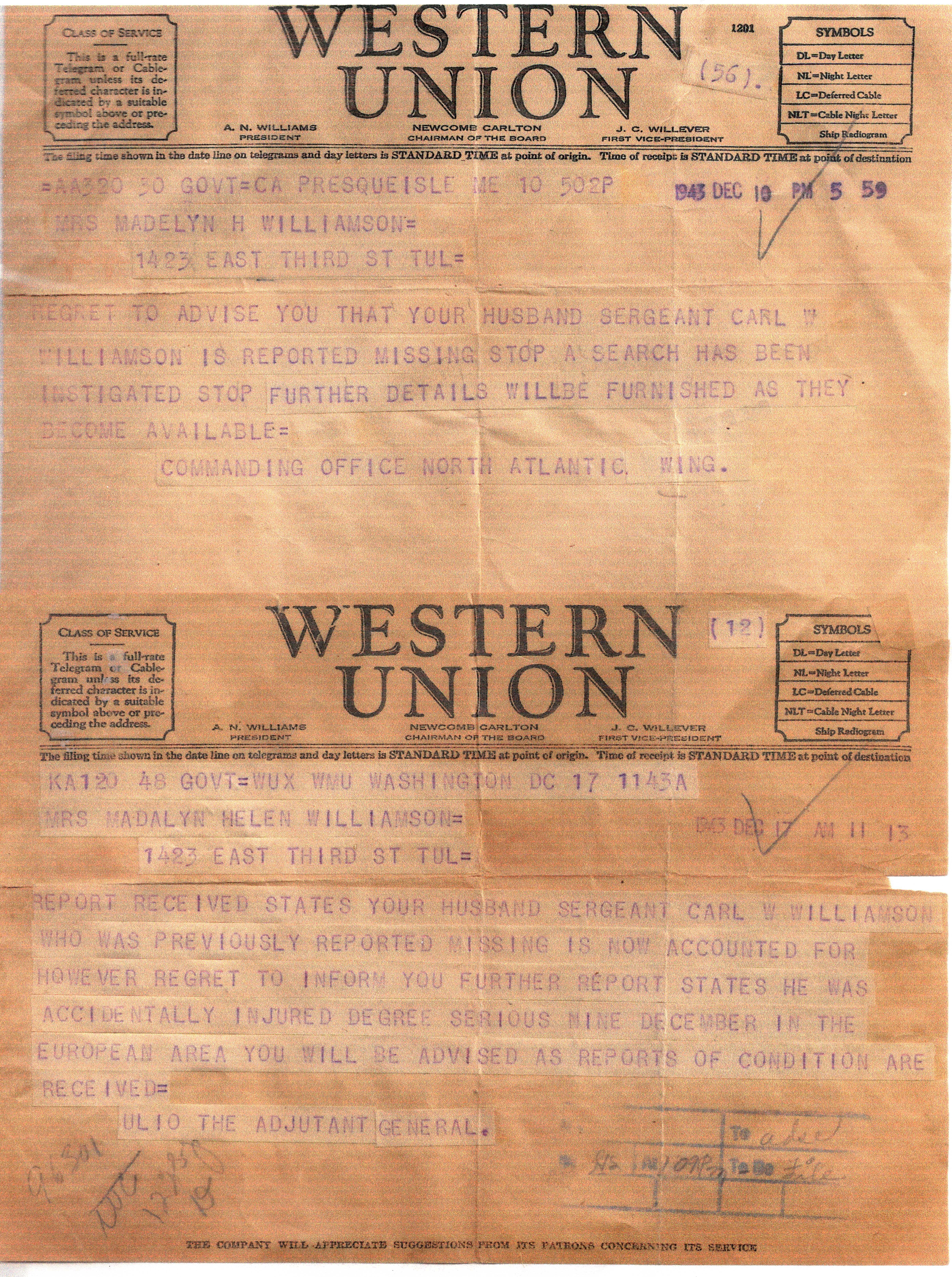
And a novel postcard sent by Carl to his wife in 1943 during his
training in the United States.
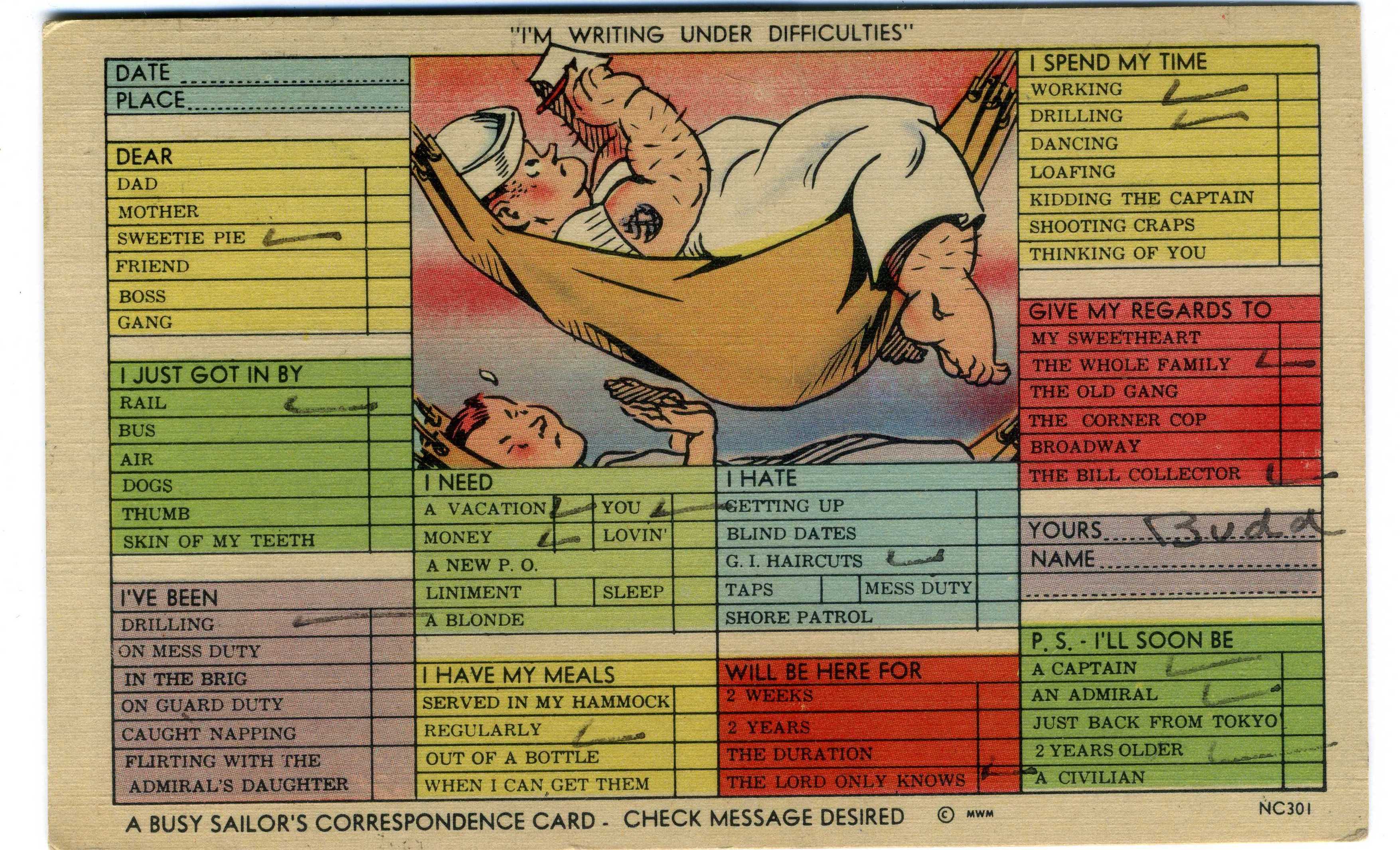
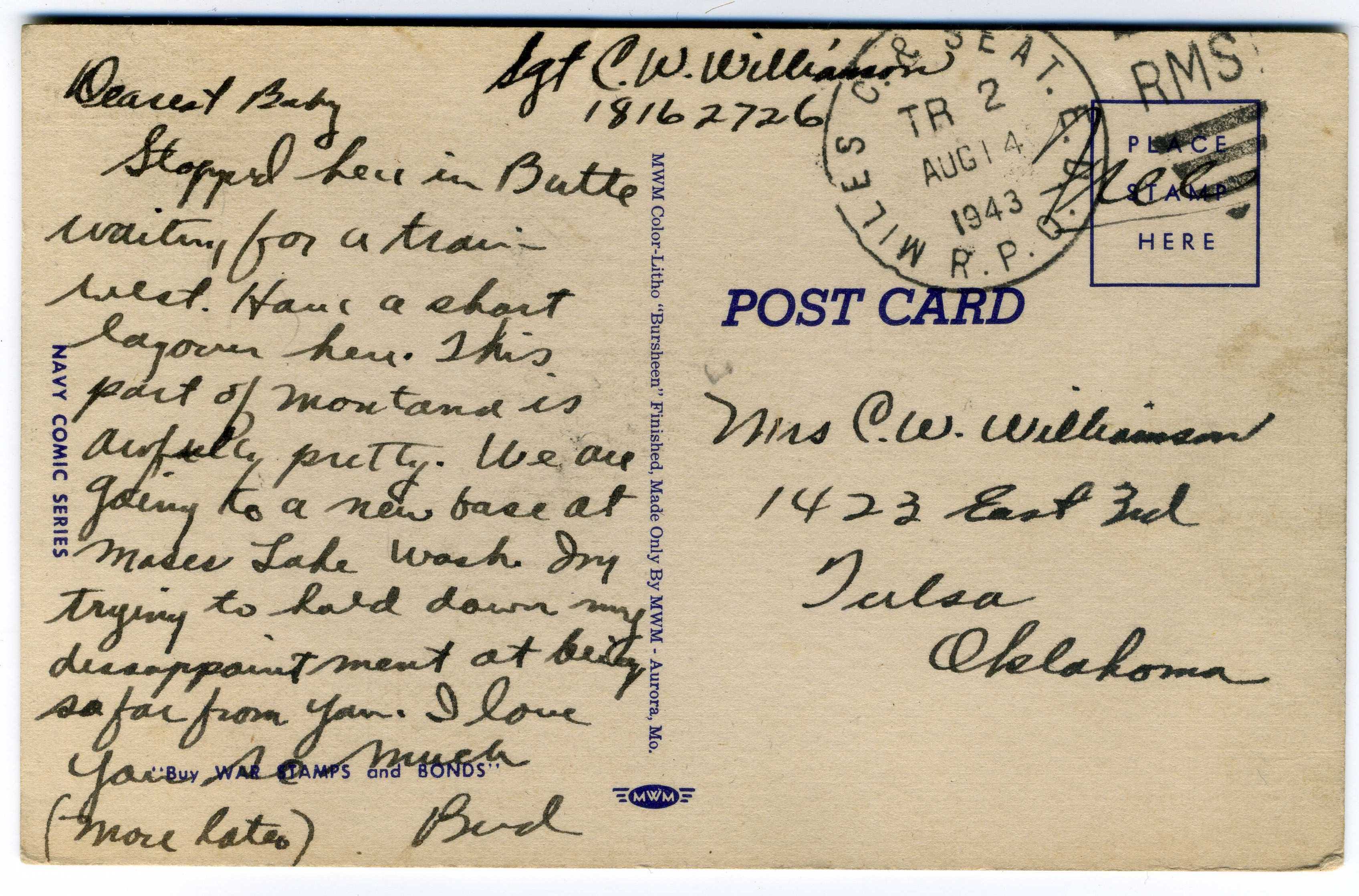
Dear Baby, stopped here in Butte
waiting for a train west. Have a short layout
here, This part of Montana is awfully pretty. We
are going to a new bases at Moses Lake Wash. I’m
trying to hold down my disappointment at being so far away
from you. I love you so much, (more later) Bud.
USAAF Crash Report of B-17G Flying Fortress 42-31420
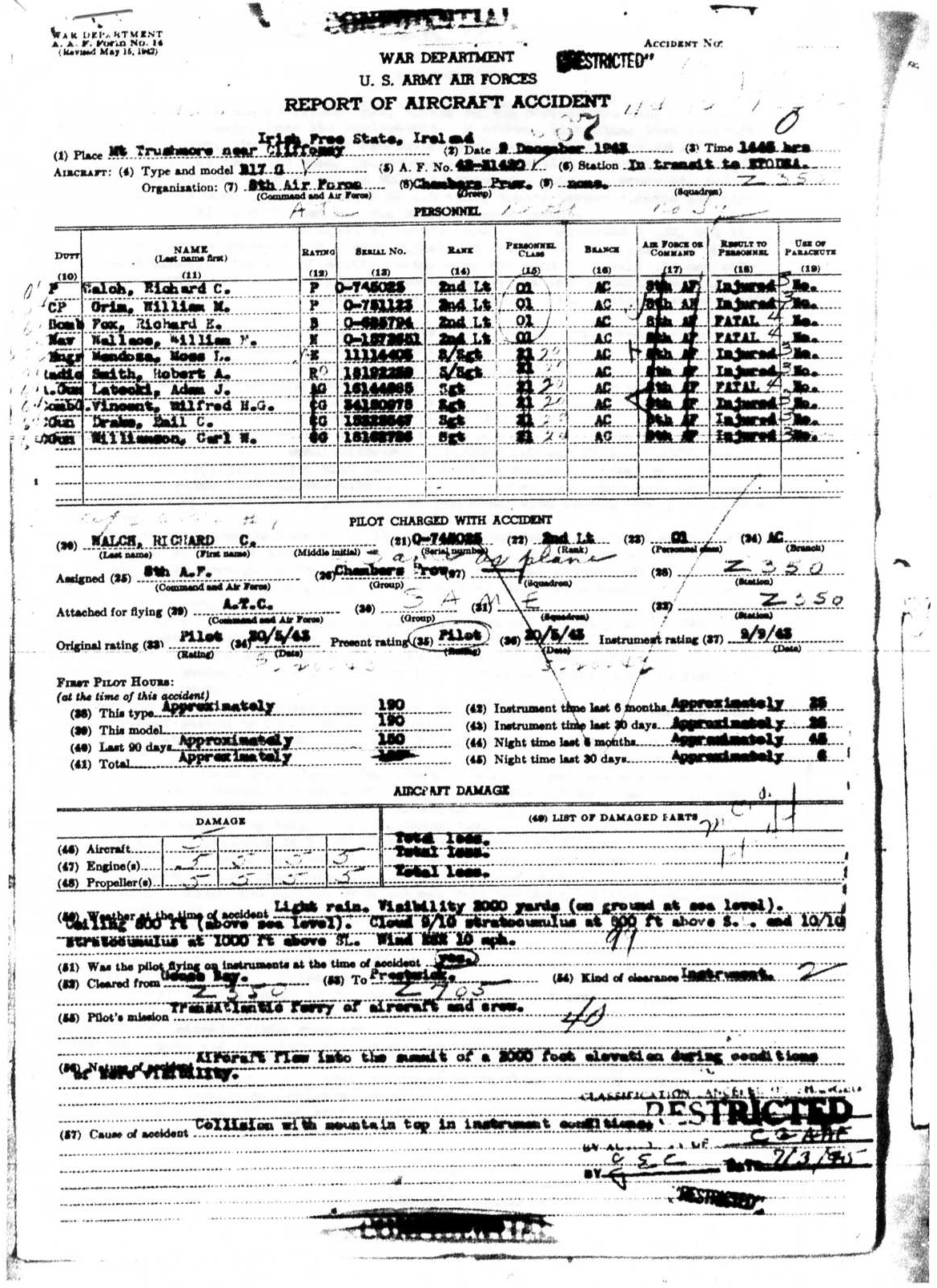
Report courtesy US Air Force Historical Support Office
The following is a transcription of the crash report held by
the Air Force Historical Support Office at Maxwell AFB.
The quality of the image from microfilm is very poor so I cannot
be certain of certain words in the report. Where I am
unsure of words, I have underlined them in the text below.
Plane was approaching Ireland at 11,000
feet, homing on the Derrynacross beacon. Course had
been changed 5 degrees only, from the navigators set
courses, indicating that aircraft was approximately on
course. Nutt's Corner operations confirm that the
first call from the aircraft (GAZA KING) was at 1346 ZED
time, requesting QDM. At 1350 aircraft called again
and told Nutt's Corner (RASAK ?) that he was at 9000 abd
descending through overcast, and requested clearance to
Prestwick (BURTON). At 1358 ZED time, Nutt's
Corner cleared the aircraft to Prestwick (BURTON) at 4000
feet and the aircraft acknowledged.
At 1426 Zed time, GAZA KING came on again to Nutt's
Corner and requested a QDM, but it took until 1440 for
Nutt's Corner to to get a good signal, at which time the
gave the aircraft a QDM of 123 (third class). The log
of Nutt's Corner does not show that this QDM was
acknowledged by the aircraft, but Lt. Walch, pilot, states
he got it and acknowledged it. The last actual call
from the ship to Nutt's Corner was at 1433, while taking
another bearing on the ship.
The navigator, in the mean time had given the pilot an
ETA on the Irish coast of approximately 1355 (which was 30
minutes before the ship actually hit). All other
aircraft flying the same course at the same time encountered
from one hour and thirty minutes to two hours and 15 minutes
delay in reaching their ETA on time, as the wind forecast
for the zone was Approximately 15 to 20 MPH at 270 degrees,
as against the actual conditions of winds varying from 20 to
25 MPH at 90 to 180 degrees, varying with altitude.
Pilot started gradual descent when the ETA came up and
passed. Hoping to break through the overcast, pilot
kept descending until altimeter indicated between 2?00 and
2?00 feet, Navigator (who had been supplying pilot with some
forecast throughout flight) prior to final let down,
indicated to pilot that maximum altitude of obstructions
would be about 2100? feet, it was estimated that they had a
fairly good line of position, upon letting down, still
steering 125 magnetic.
At this point there was some concern about the gasoline
reserve, on the part of the pilot, and due to the passage of
time of the ETA on the Irish coast he decided to land at
Nutt's Corner, rather than go on through to Prestwick.
Although the fuel gauges indicated that he had 500 gallons
of gas left, Lt. Walch (pilot) stated that he had little
confidence in the accuracy of the fuel gauges.
Finally, immediately prior to the accident, pilot
levelled off slightly below 2000 feet indicated on his
altimeter, at which moment the Co-pilot sighted ground
below, through a break in the cloud, and called the pilots
attention to it. Lt. Walch states the last thing he
remembers is reaching for the up elevator knob of the
automatic pilot to start climbing when the crash came.
At the time of the accident and immediately prior to,
aircraft was not marking any radio ranges. It was
further stated by Lt. Walch that at no time had the aircraft
done any 'milling around' or changed course radically, even
to the point of making a turn of more than 5 or 7 degrees.
A take off was made at Goose Bay prior to the start of
this flight, but due to some trouble with the fluxgate
compass, the aircraft returned to Goose Bay to check it and
refuel, involving a loss of time of about 2 hours for
refueling and checking the compass. No new weather was
received during this return to Goose Bay.
Approximate location of accident is 6 3/4 miles true
azimuth 143 degrees from Mullaghmore Head (Darby Hole) on
Donegal Bay, western coast of Ireland. 2000 yards true
azimuth 20 degrees from the summit of Truskmore. 5
9/10 miles true azimuth from town of Bundoran 211
degrees. 3 miles 100 degrees true azimuth from
Ballaghnatrillick crossroads. Approximately 54 degrees
23 minutes and 45 seconds North Latitude, and 8 Degrees 22
minutes East longitude.
The board believes that the accident was actually
caused by error in judgment on the part of the pilot in
descending below 4000 feet. The board would like to
point out that the pilot was notified to proceed to
Prestwick at 4000 feet and acknowledgement was received at
Nutt's Corner. Further, the briefing manual covering
entry into the United Kingdom over the North Atlantic route
requires that under instrument conditions, approach will be
made at 5000 feet, and the plane will remain at 5000 feet
until directed to change altitude. If altitude had
been maintained no difficulties would have been
encountered. The board would like to recommend that
minimum altitude be stressed to crews during briefing, to
obviate such accidents. Pilots altimeter must have
been in error somewhat, which cannot be explained but the
fact remains that if airplane had remained at 4000 feet
there have been adequate clearance over the mountains.
Notes:
Radio Call signs for Prestwick, Nutt's Corner and the aircraft
are the words in brackets in the text above. Nutt's Corner
call sign needs to be confirmed.
Times in the initial text are in GMT or Zed, Zulu time.
QDM – Magnetic heading to be steered by the aircraft (assuming
no wind) to reach the VDF station
William M Grim's daughter Gretchen was able to pass on this
transcription of a report her father left of the crash which he
prepared for Moss Mendoza.
Department of the Air Force
Summary of Dec. 1943 Accident
On 9 December 1943, the pilot, second Lieutenant
Richard C. Walch, and his crew took off from Goose Bay,
Labrador in a B-17G, serial number 42-31420, for a
transatlantic ferry mission to Prestwich, Ireland. They lost
about 2 hours when they returned to Goose Bay for repair of
their radio compass and refueling. They were at 11,000 feet
when they approached the Irish coast and homed in on the
Dearnyeress radio beacon. Nutt’s Corner
Operations first talked to the air crew (call sign
GAZA King) at 1346 ZED, requesting QDM. At 1350, the crew
reported they were at 9,000 feet and descending through an
overcast and requested clearance to Prestwich. At
1358, Nutt’s Corner cleared the aircraft to Prestwich at
4,000 feet, and the aircraft acknowledged. The navigator had
given an estimate to the Irish coast of 1355, but arrival
over the coast was not until 1425. All other aircraft flying
the same route were from 30 minutes to 2 hours later than
their estimate doe to wind. At 1426, GAZA King requested a
QDM, but it was 1440 before Nutt’s Corner got a good radio
signal and game the aircraft a QDM of 123 (third class).
They continued their descent, steering 123 magnetic. The
crew reported they would land at Nutt’s Corner rather than
continue to Prestwich due to low fuel and the distance
remaining. The copilot reported sighting the ground through
a break in the clouds. Shortly thereafter, the aircraft
impacted the summit of a 2,000-foot mountain top. Crash
location was 6-3/4 miles and 143 degrees from Mullaghmore
Head (Darby Hole) on Donegal Bay, western coast of Ireland
(also described as true azimuth of 20 degrees and 2,000
yards from the summit of Mt. Trushmore).The aircraft was
destroyed, but Lieutenant Walch and six of his crew survived
with some injuries, while Second Lieutenant Fox, the
bombardier, and Second Lieutenant Wallace, the navigator,
received fatal injuries.
Statement of Fact
William M. Grim; Notarized on Oct. 11, 1991
[provided at request of Moss Mendoza, Engineer]
Subject: To the best of my knowledge, these are
the events leading up to, during and after our B-17G
aircraft impacted a mountain in Southern Ireland on 9
December 1943.
To: Whom It May Concern
I, William M. Grim, 2nd Lt., Army Air Corps, was on 9
Dec. 1943, copilot of a B-17G, serial number 42-31420, for a
transatlantic ferry mission to Prestwich, Scotland. We
encountered unexpected strong headwinds en route to a point
that fuel consumption became a matter of grave concern. We
also encountered unexpected heavy cloud cover upon reaching
the coast of southern Ireland. These developments resulted
in a decision to make an intermediate landing for refueling
at Nutt’s Corner, Northern Ireland. As we proceeded on
course, visibility became zero; and during descent to gain a
minimal visual ground reference into Nutt’s Corner, we
impacted the summit of a 2,000-ft. mountain approximately
6-1/2 miles from Mullaghmore Head (Darby Hole) on Donegal
Bay.
I gained consciousness on the ground on the port side
of the aircraft. When I was able to get up, I noticed that
the navigator and bombardier were also on the ground and
both appeared to have had fatal injuries. I then made my way
to the plan to inspect the damage. It appeared that
everybody I could see was down and injured. I particularly
remember S/Sgt. Moss Mendoza (engineer) on the floor of the
radio room in a very awkward position and asking for help.
He had what appeared to be a serious head injury.
The impact had tossed him from his regular station
(starboard side) across the plane to the radio operations
post (port side) with a force that resulted in his left leg
breaking through the bulkhead. When I tried to help him, I
discovered that both of my arms were broken and I was unable
to assist. At this time, Lt. Walch, pilot, came in from the
cockpit area. He was very disoriented and appeared to have a
serious head injury.
The need for help was obvious. Lt. Walch and myself,
the only surviving crew members who were somewhat
ambulatory, headed down the mountain to seek assistance.
The family of Dr. Evelyn Flanaghan (nee Connolly) very kindly
contacted me during this study and provided some background
information and photos. Evelyn's first locum was the Arran
Islands and then Cliffoney in County Sligo. She spoke
often to her family of her experiences that night. They
understand that she was offered a medal by the American
Government but couldn’t accept due to Ireland being
neutral. She did receive a cheque to compensate for her
damaged clothing.
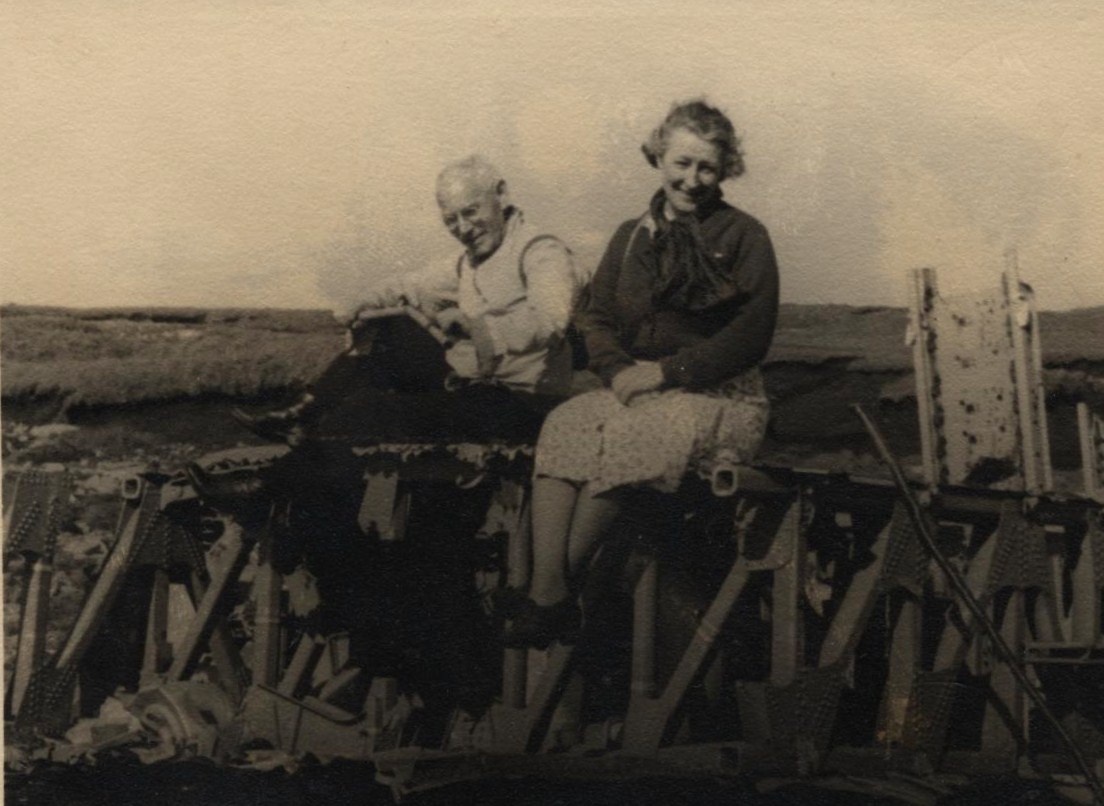
The photo above was taken when Evelyn visited the crash site
during the 1950’s or 1960’s with her husband Dermot, Tommy
Connolly and local parish priest Canon Casey. Canon Casey
is shown in the photo above with Evelyn.
Her family recall that after the war one of those on board the
crashed aircraft returned to Mullaghmore landing on the beach
there. They all went to the local pub where he gave his
hat to the innkeeper. Evelyn kept in touch with some of
the survivors. Evelyn was an all round doctor, as her
nearest hospital was 15 miles away she had to turn her hand to
all parts. She was in fact doctor to Lord and Lady
Mountbatten who owned the castle in Mullaghmore and visited
every summer. She married Dermot Flanagan in early 1945 in
Sligo. Evelyn’s neice and great nephew sent on these
photos of her.
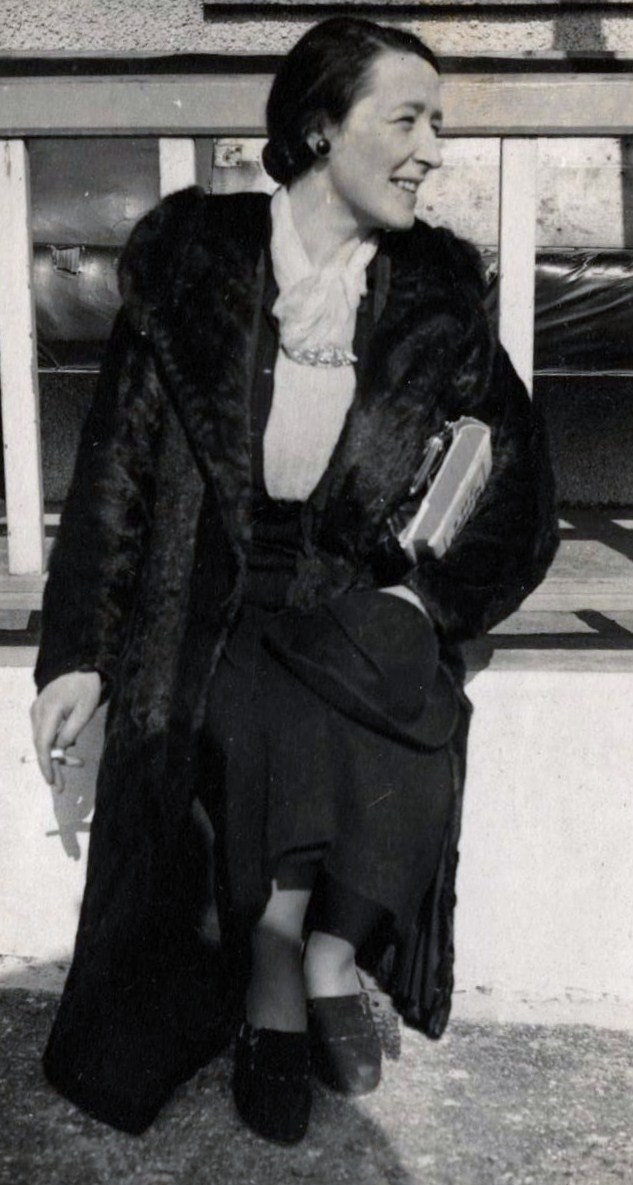
Evelyn later in life, above, dressed up.
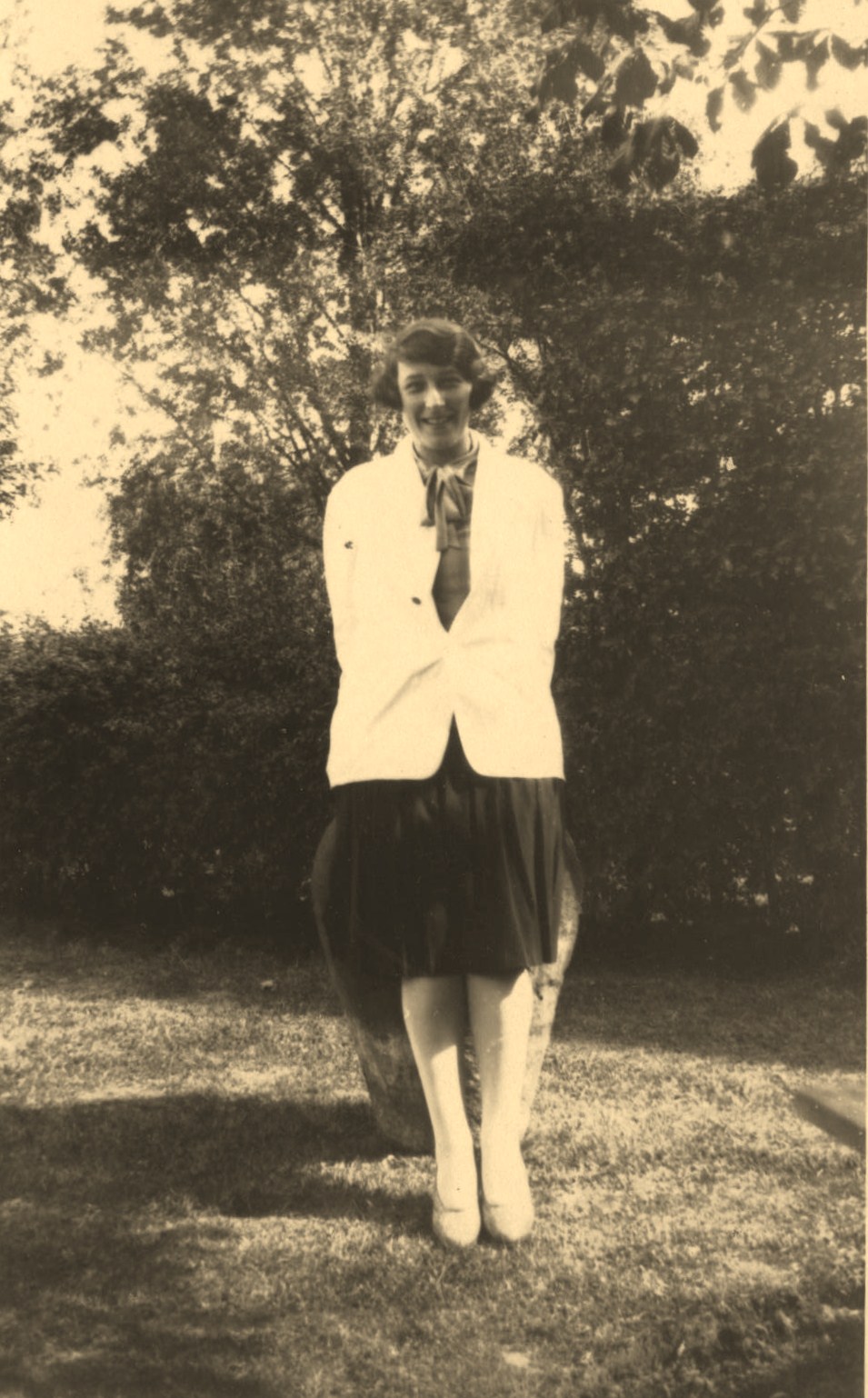
Evelyn as a student in the 1920’s.
The crash location and wreckage
Note: For anyone planning of visiting
the crash site, it is a steep walk, if there is a chance
that visibility is poor, think ahead and plan your equipment
and hiking abilities before going up as there are cliff
edges in some places, mountain top lakes and bog holes as
well as gullies. Take great care. And finally,
very little remains of the wreckage, please try not to
remove any more parts of the limited remains.
The crash occurred on the western edge of the mountain or ridge
shown as Teivebaun on modern Ordnance Survey Ireland maps.
Mount Truskmore is the highest mountain in the Dartry Mountains
and straddles the Country Sligo and Leitrim Borders. It is
immediately to the east of the famous Benbulben mountain and is
in an area of outstanding natural beauty. Running north of
Mt. Truskmore is the further height of Tievebaun.
Not far from the location of this crash, in March 1941, Catalina
AM265, a flying boat of 240 Squadron, Royal Air Force, crashed
killing eight airmen. This incident occurred in County
Leitrim on the eastern face of the mountain.
In the 1950's, local man Sean Gallagher sent the following
images of the wreckage to crash survivor, Bob Smith.
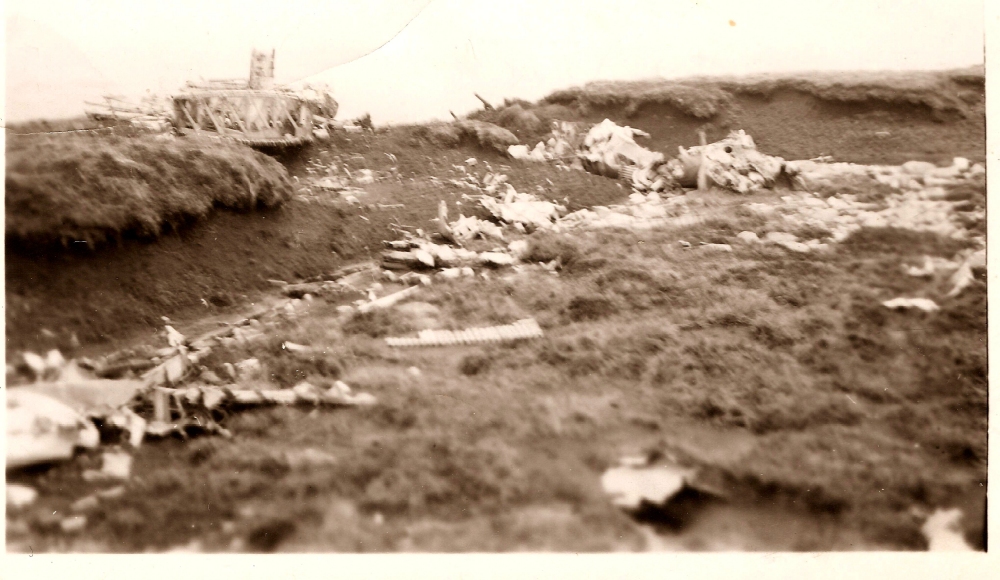
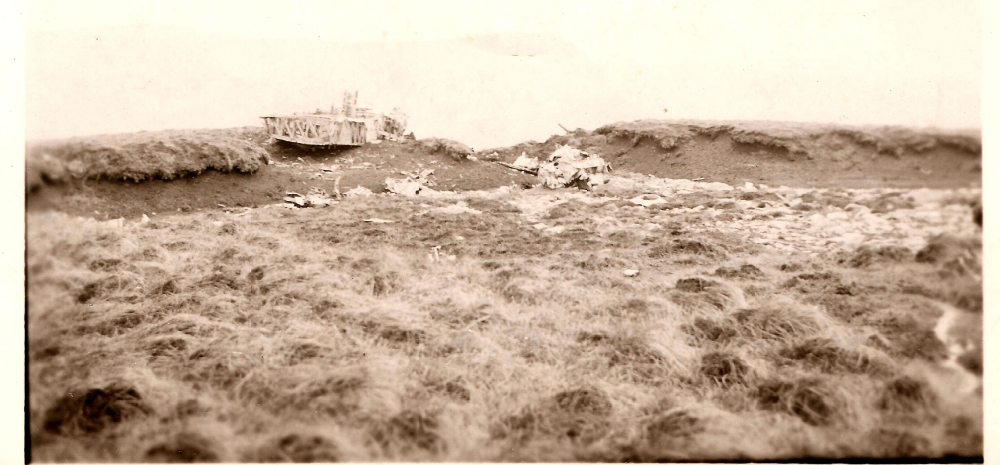
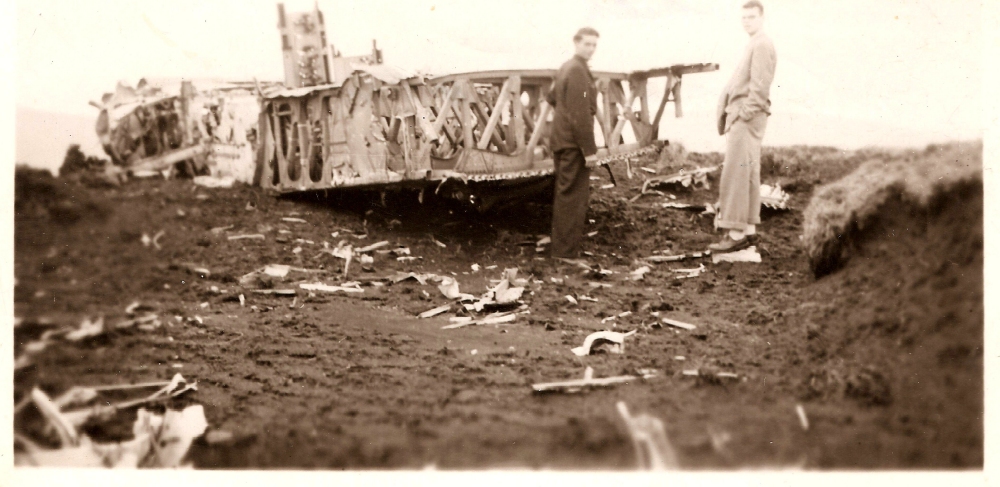
In 1962, the Irish national broadcasting company, Telefis
Eireann built a television transmitter on the top of Mount
Truskmore some distance from the crash site. A road was
built up to the transmitter but even this is quite steep and a
trying walk. The road is company property and not meant
for public access. Furthermore, many of the local farmers
are unhappy about hill walkers being in the area so access is
officially difficult. In the mid 1990's when researchers
Ronald Lee and John Quinn made trips, separately, to the site
there were still engines and a large section of wing on the
mountain. In 2005, the Irish Air Corps flew two of the
engines off the mountain for use in the Irish Air Corps
Museum. Other remains of the aircraft structure were left
at the site at that time and are expected to still be there in
2009. I (Dennis Burke) did walk up the service road
to the transmitter in May of 2008 but not having any reference
information with me I was unable to find where the crash site
was.
In the 1990’s Mr. Ron Lee an aviation enthusiast made investigations about the crash and was able to talk to more of the local people at that time. He was also able to find numerous parts of the aircraft wreckage on local farms being used as gates and fences. The largest piece of wreckage to be found then was a section of the fuselage including the upper fairing for the radio compartment. It was the fuselage above the bomb bay area with part of the upper fuselage fairing and life raft stowage compartments. It had been bought down the mountain and was used as a chicken shed and later as a play area for the farmers grandchildren. Local farmers recalled how they had gone to the wreckage and taken it apart for such uses. Speaking to locals during 2009 it seems that not much of these items still exist.
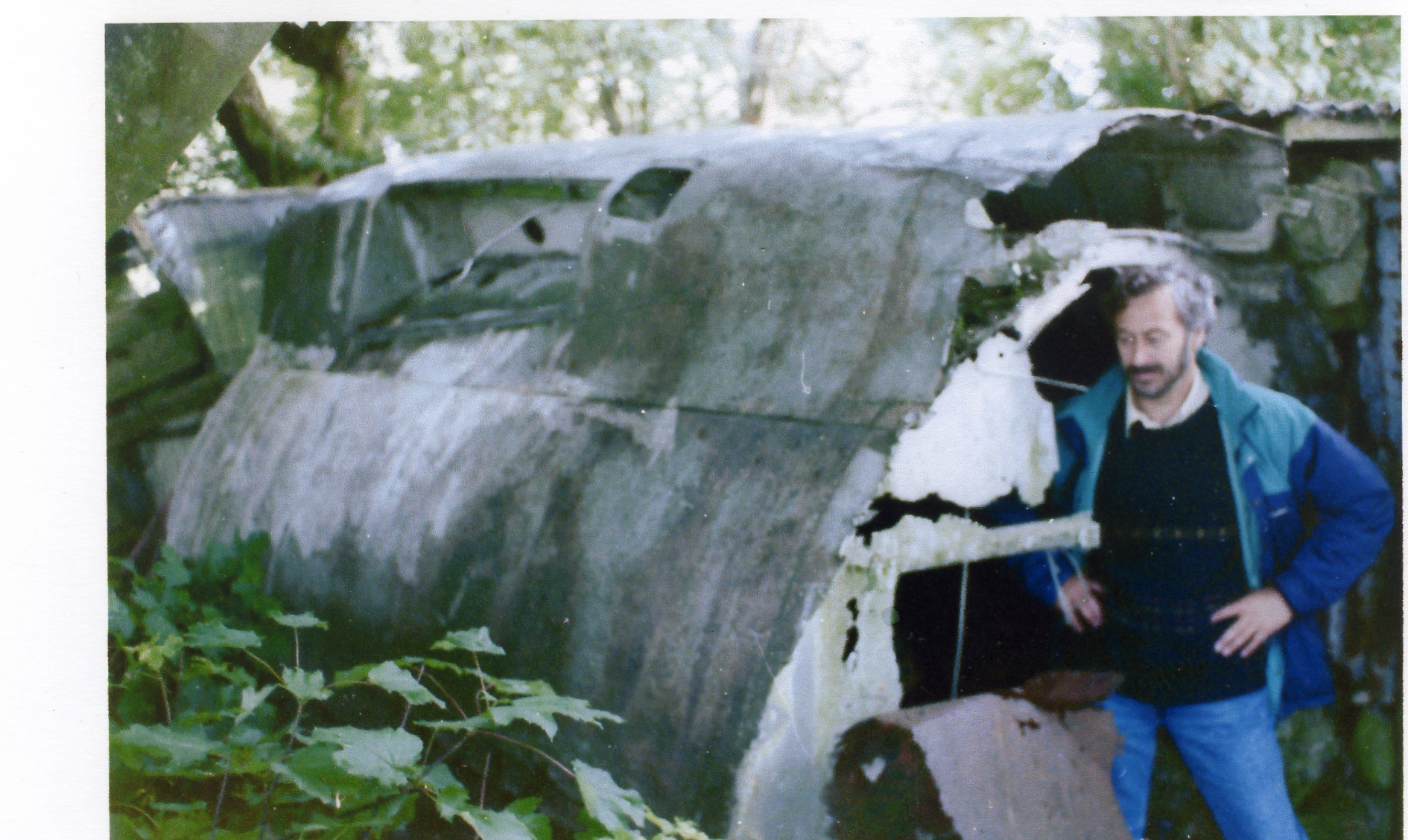
Ron Lee next to a shed built from a quarter section of
fuselage. Visible is the liferaft stowage compartment
along the top spine of the bomber (Photo: Ron Lee).
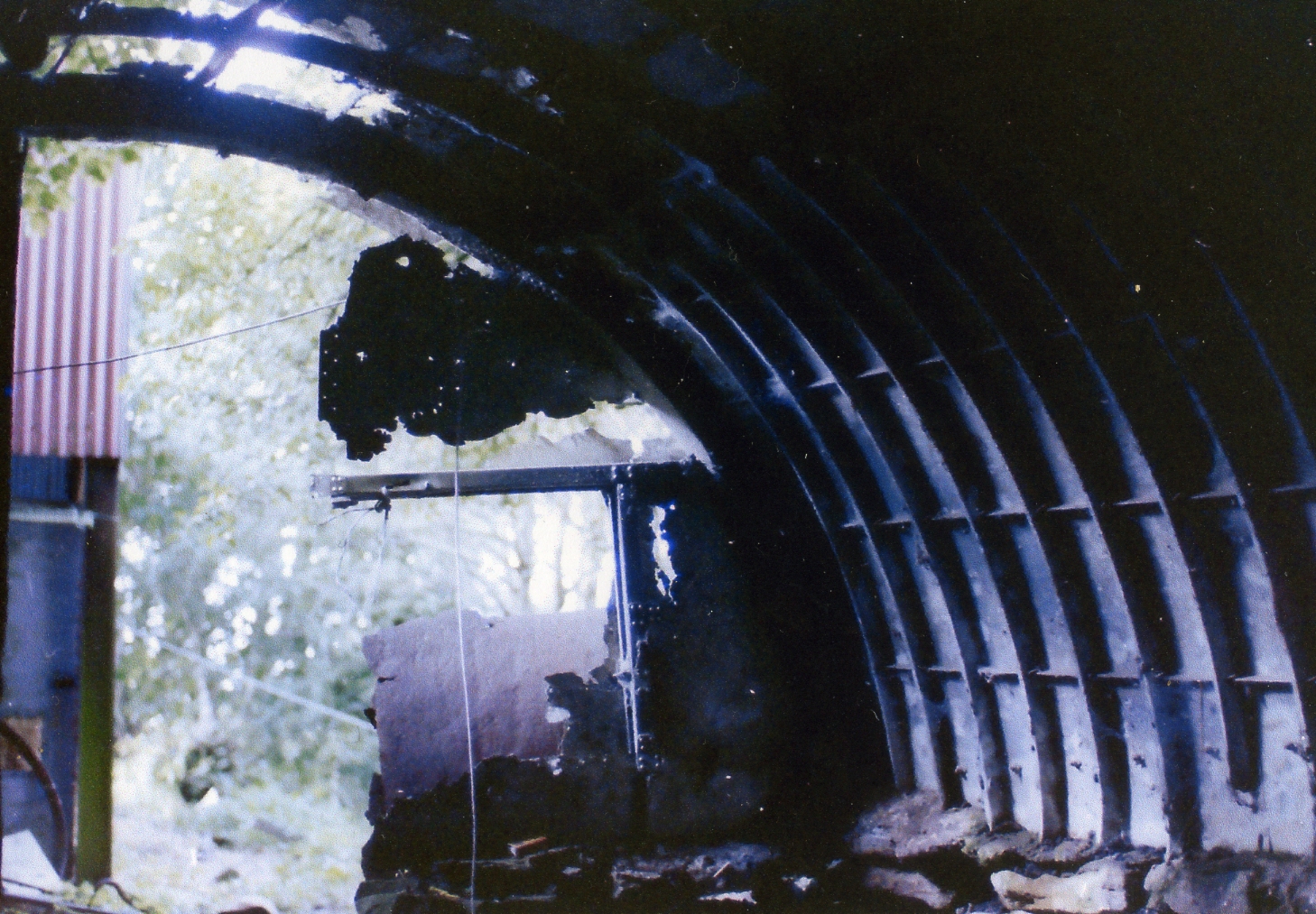
One of Ron Lee's photo's taken inside the bombers shell.
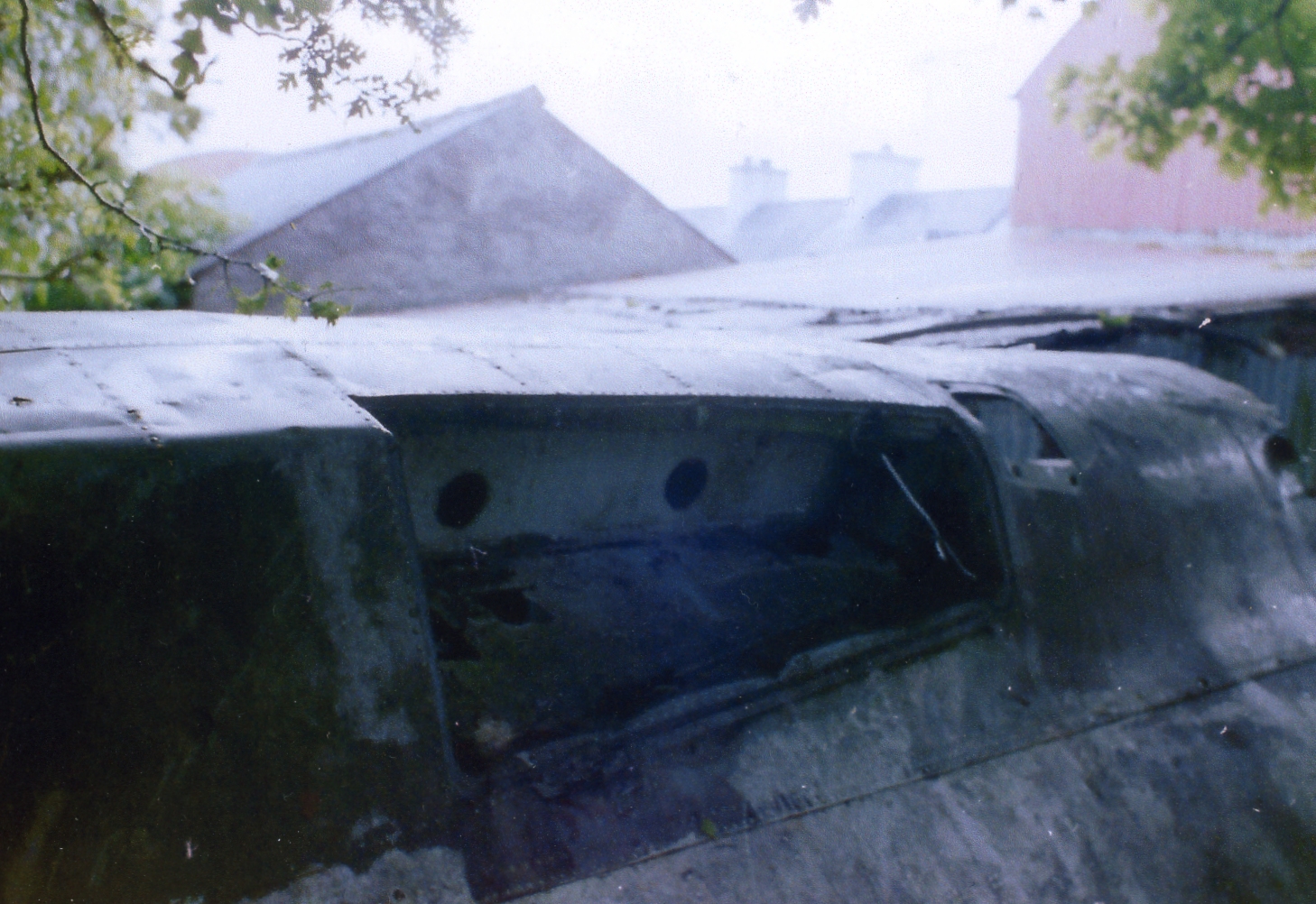
A close up on the life raft stowage.
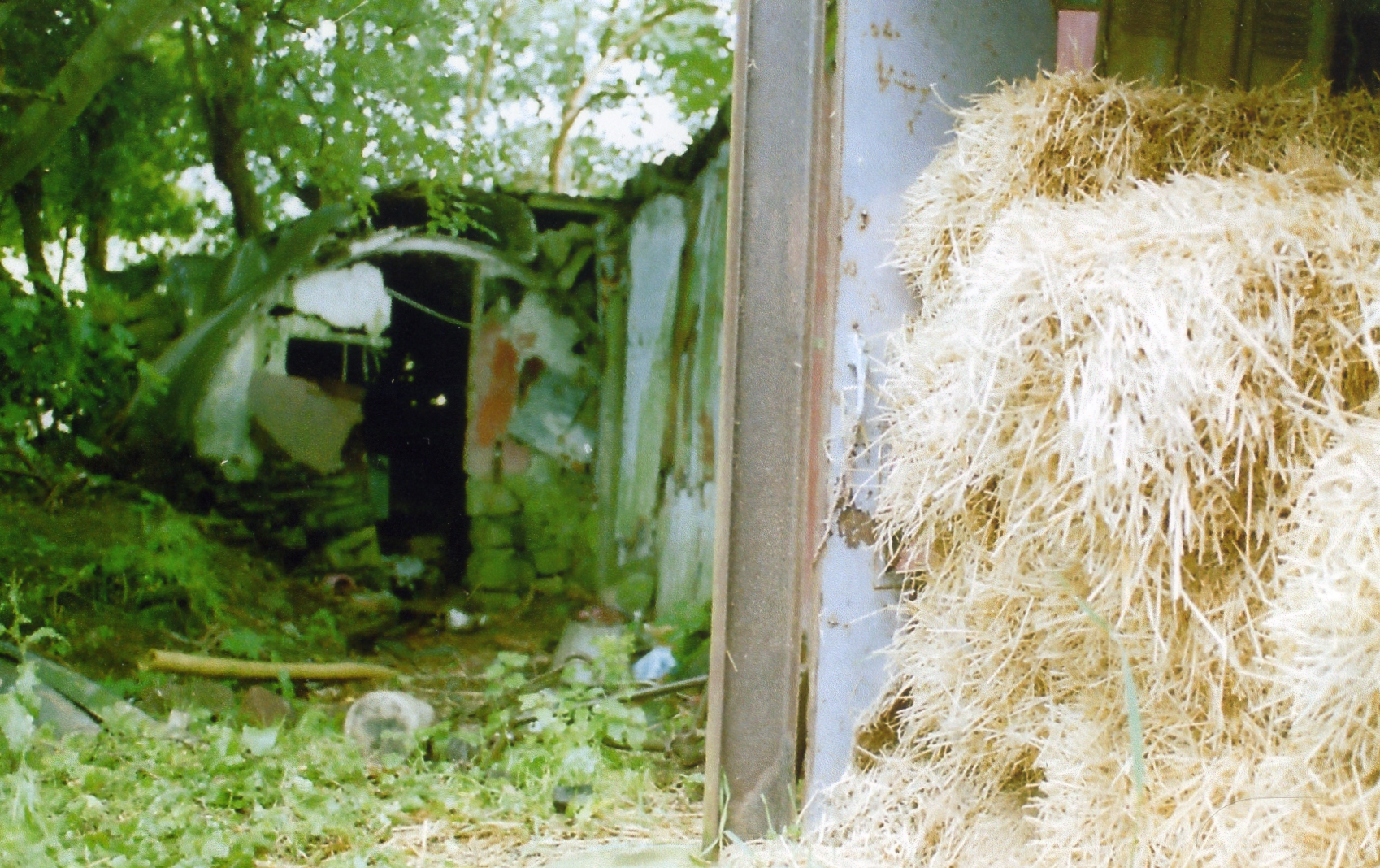
The B-17 shed!
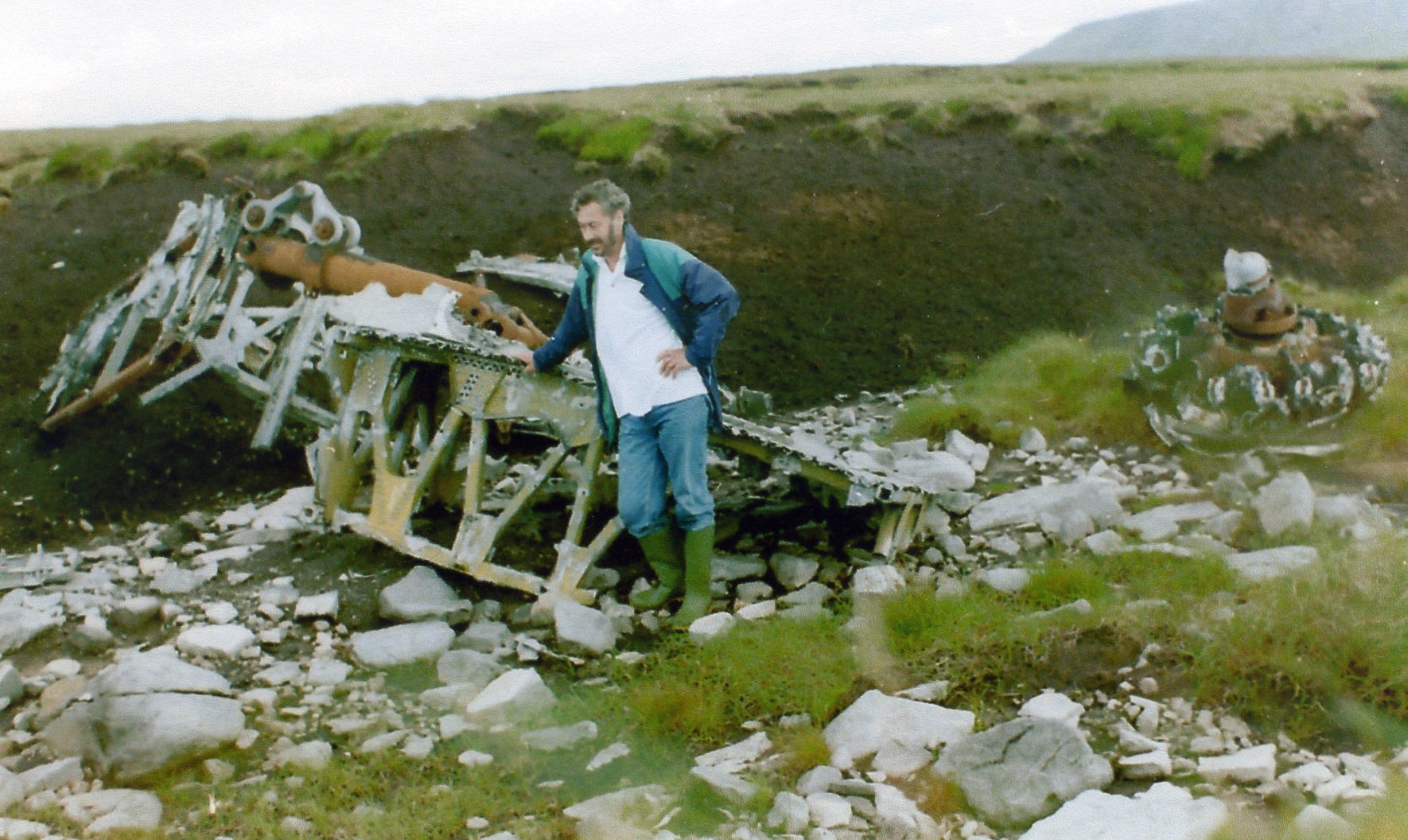
Ron pictured at the wreckage in the 1990's, compared to the
earlier 1950's or 1960's images above, the wreckage was
diminishing over time.
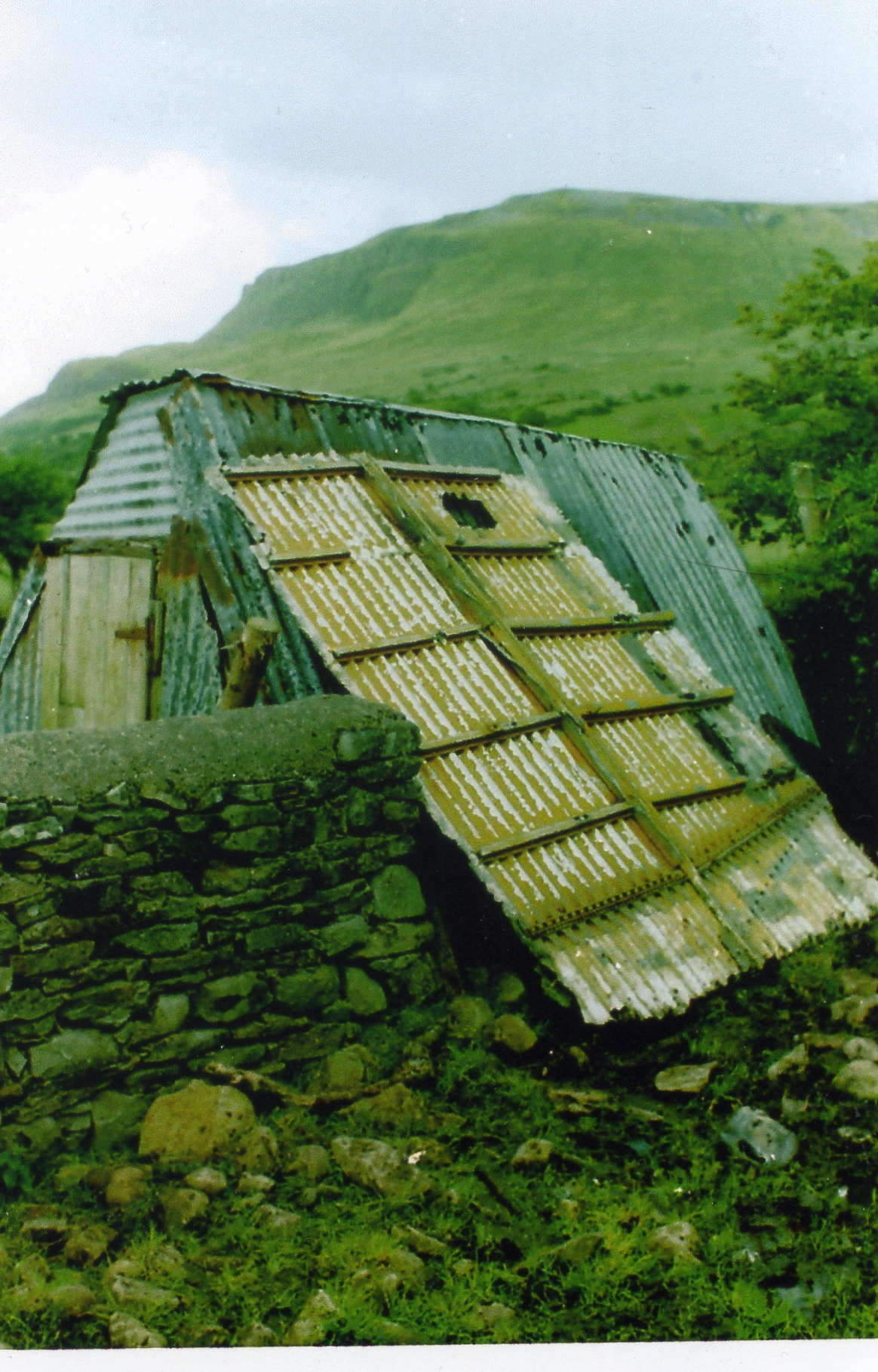
A large section of the aircraft forming a shed.
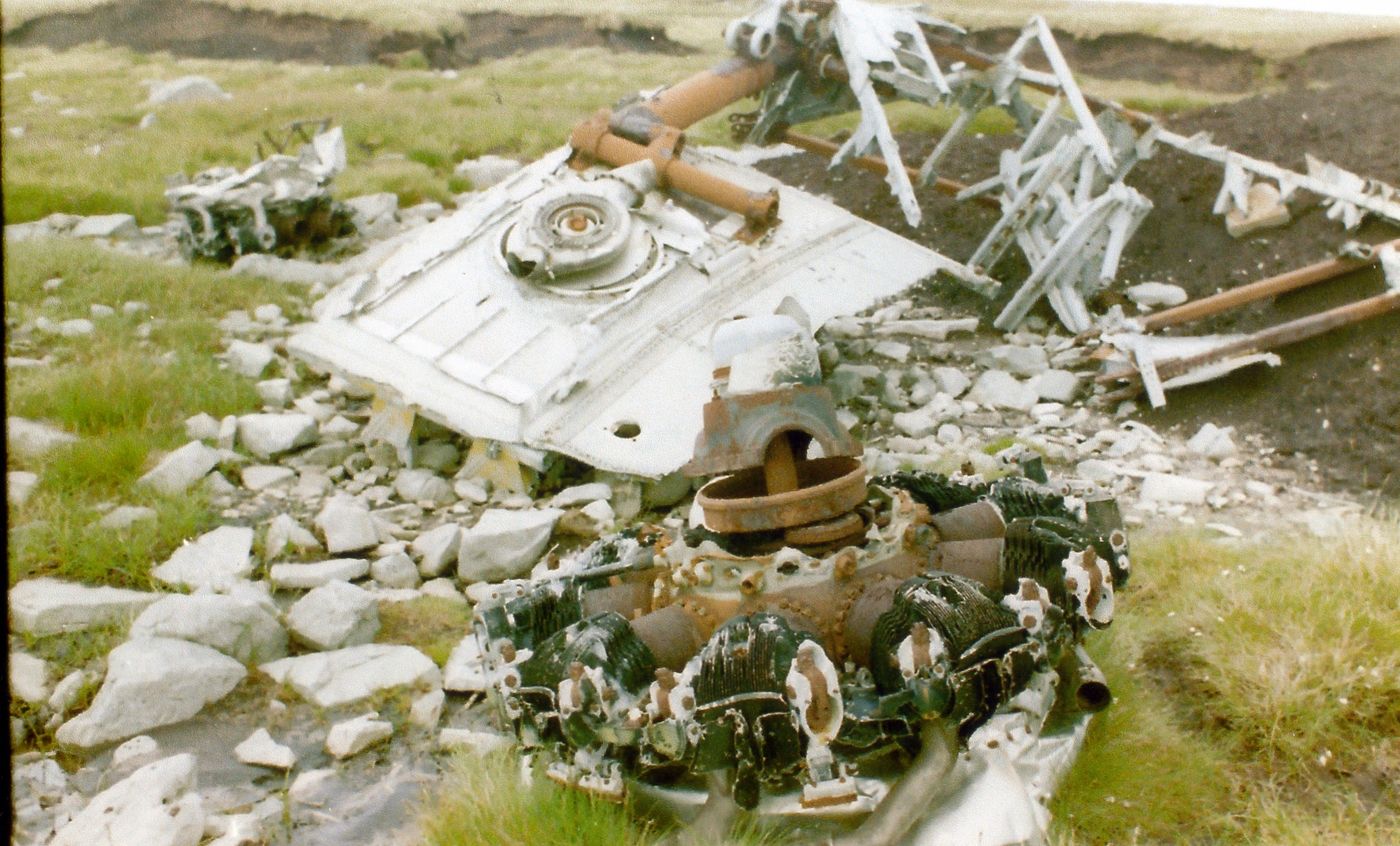
The wing wreckage and two of the engines that once lay on the
mountain.
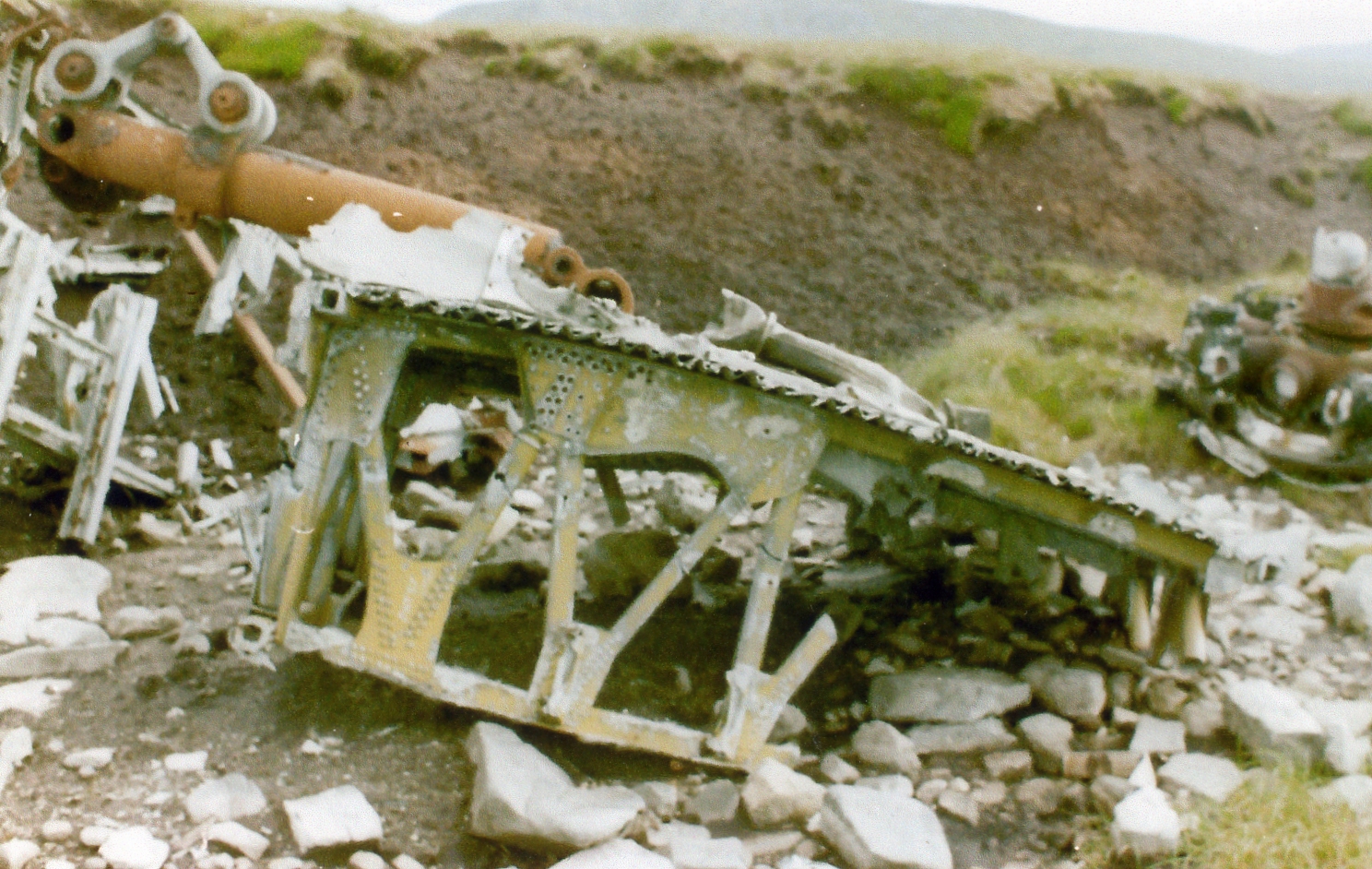
The wreckage of the wing section.
During 2009, I was kindly sent photos and descriptions of the
way to the site by local Dave Rooney and Spanish walker, Michel
Lozares.
Finally, on a gloriously sunny day in June 2010, I managed to
make my way up the mountain from the old entrance road to the
Rooney’s cottage. Walking alongside one of the gullies
with runs down the west side of Tievebaun as advised by Michel
Lozares. The walk up was for me very tiring due to current
fitness state but the top was reached after about one and half
hours. The slope is rather steep and one has to lift
oneself up all the way. The location of the wreckage is a
little further north along the mountain, behind the cliffs
visible from the valley floor. All that remains is the
large wing section with landing gear leg attached, seen in most
photos that were sent to me from the last 20 years. The
other landing gear leg is also present along with two structural
frame items. The ground area is strewn with little
fragments of metal. Back along the gully where it lies is
what appears to be an engine firewall. Comparing my photos
taken in 2010 with those from the 1950,s shows the amount of
work that was put in to dismantle the remains of 42-31420.
The wreckage that does remain carries the evidence of efforts
taken to hack it up. Hopefully, these last few pieces can
be left on the mountain in memory of the young men who flew her
there in 1943.
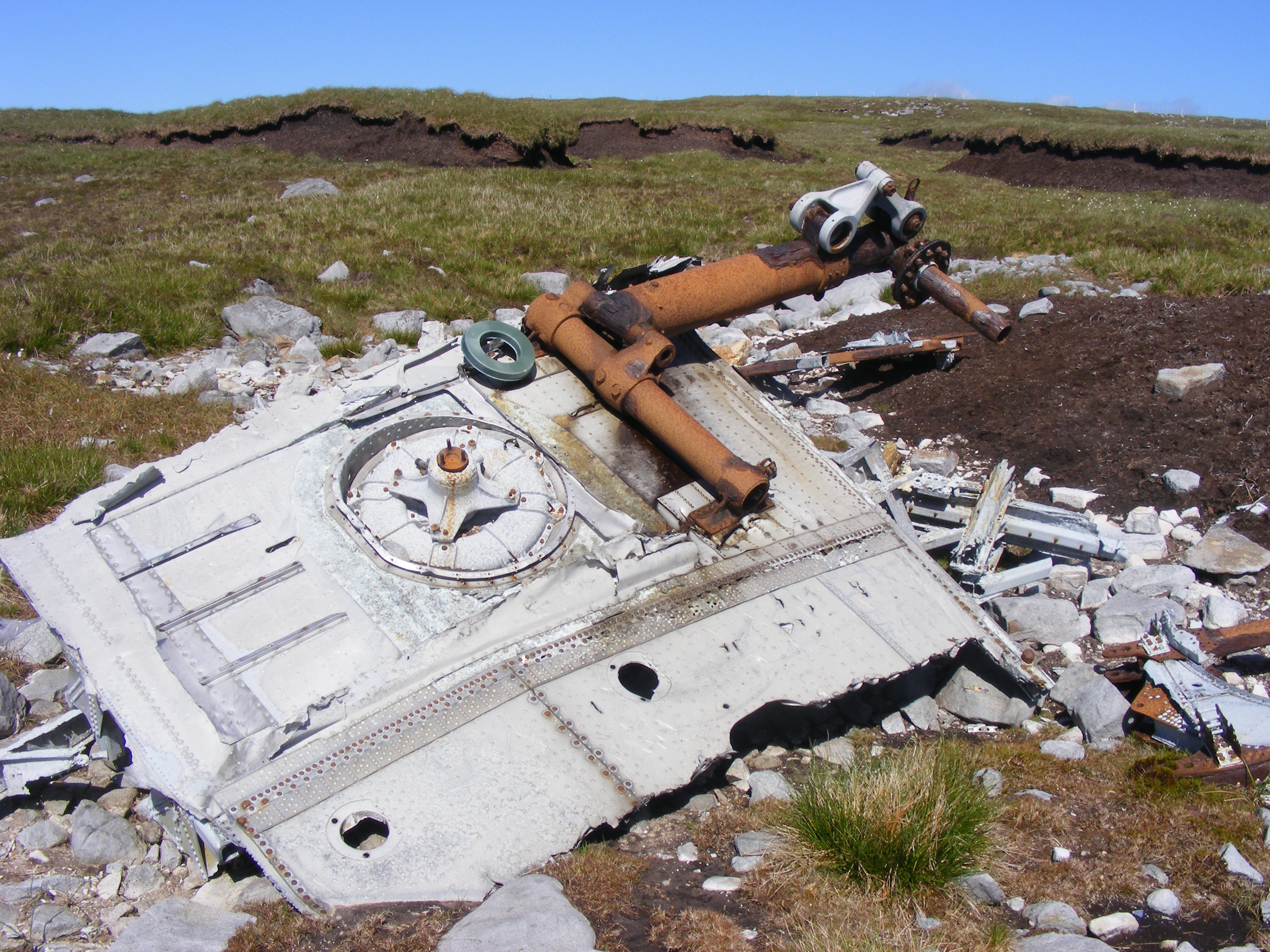
The landing gear leg, still attached to the wing structure, with
the behind it the base of the former turbo-super charger.
(Photo: D. Burke)
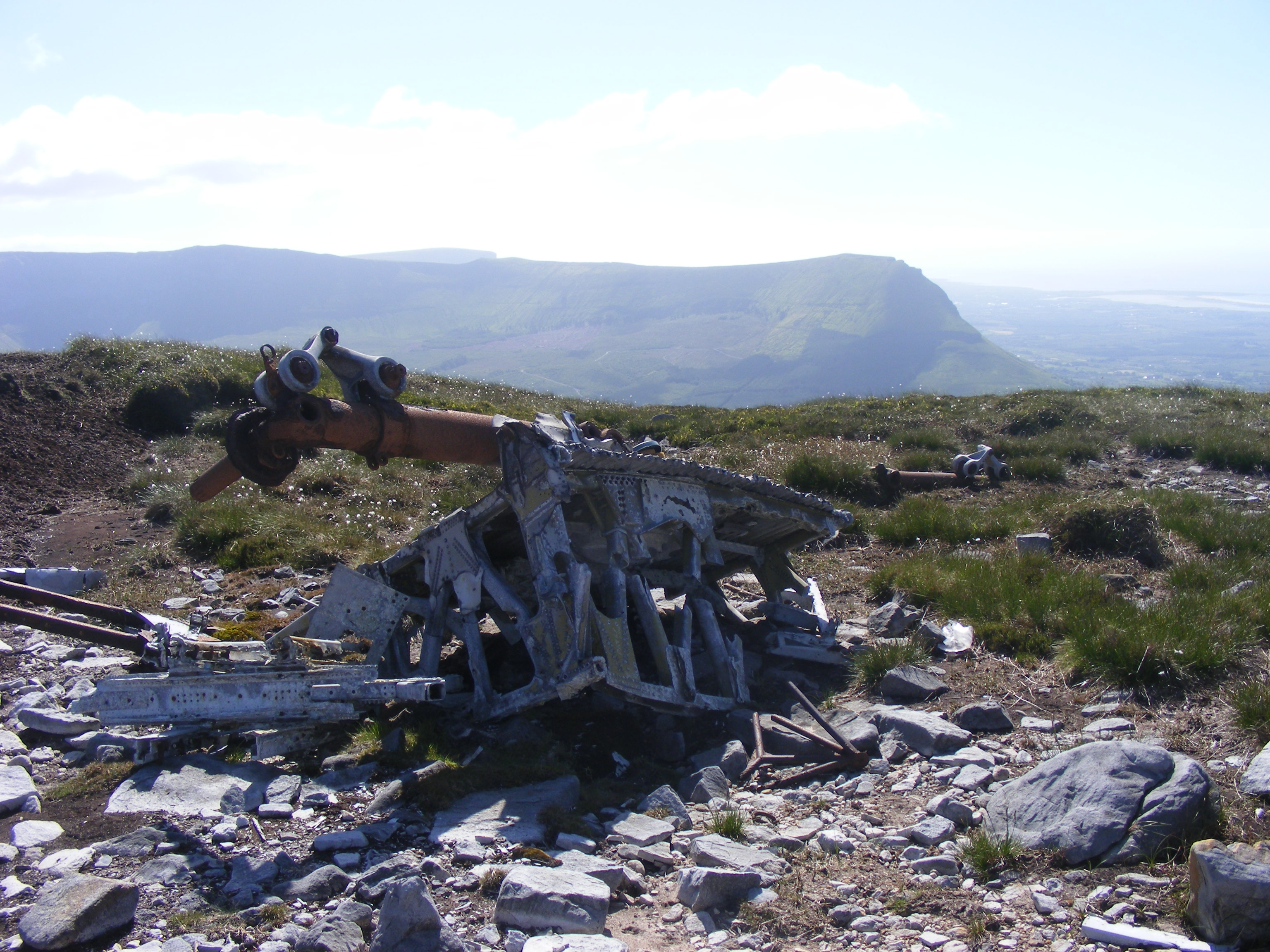
The wreckage as it lay in June 2010 not far from the top of
Tievebaun, with Benwiskin Mountain in the background.
(Photo: D. Burke)
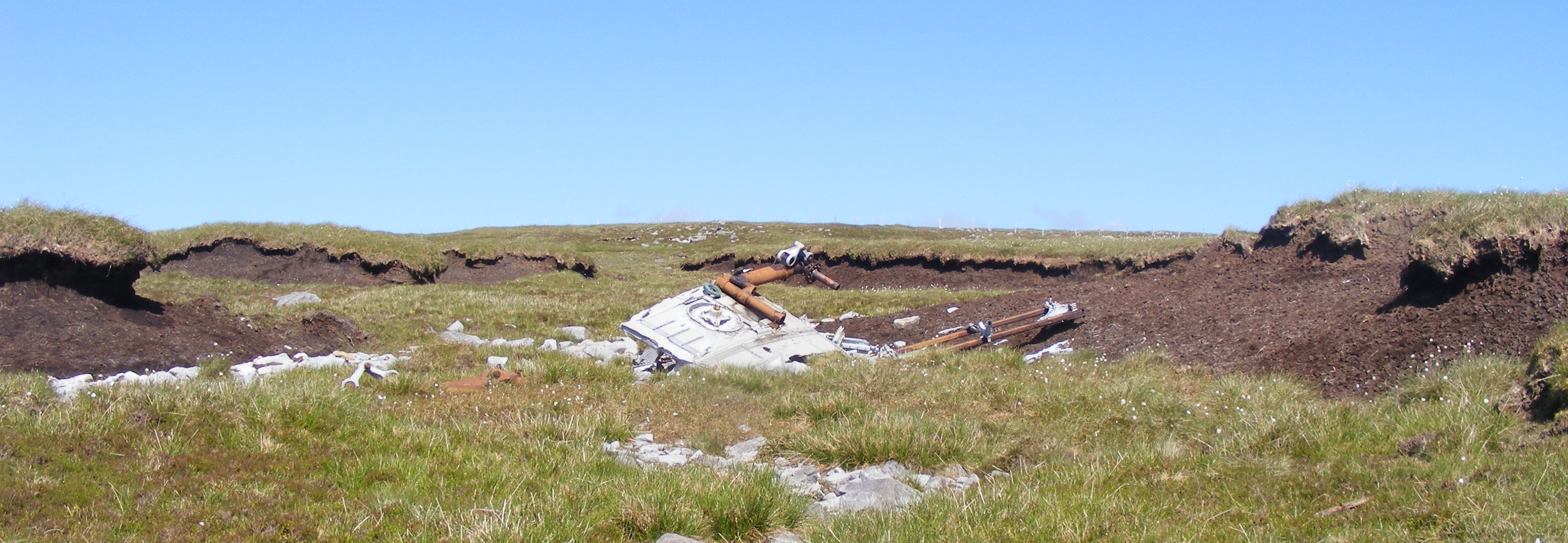
The view of the wreckage as I approached from up the
mountain. (Photo: D. Burke)
Having done this walk, it gave me a great appreciation for the
toil undertaken by those who went up the mountain to help the
injured. I had the pleasure of doing this on a sunny day
after a good number of weeks of very fine weather. It
should also be pointed out that locals would have farmed this
area probably bound up and down this slope at will, and
certainly their descendants would probably think nothing of
having to go up during a days work.
The general location of the crash, with Sligo, Ireland and
Belfast, Northern Ireland is shown for reference below. (Taken
from Google Maps.)
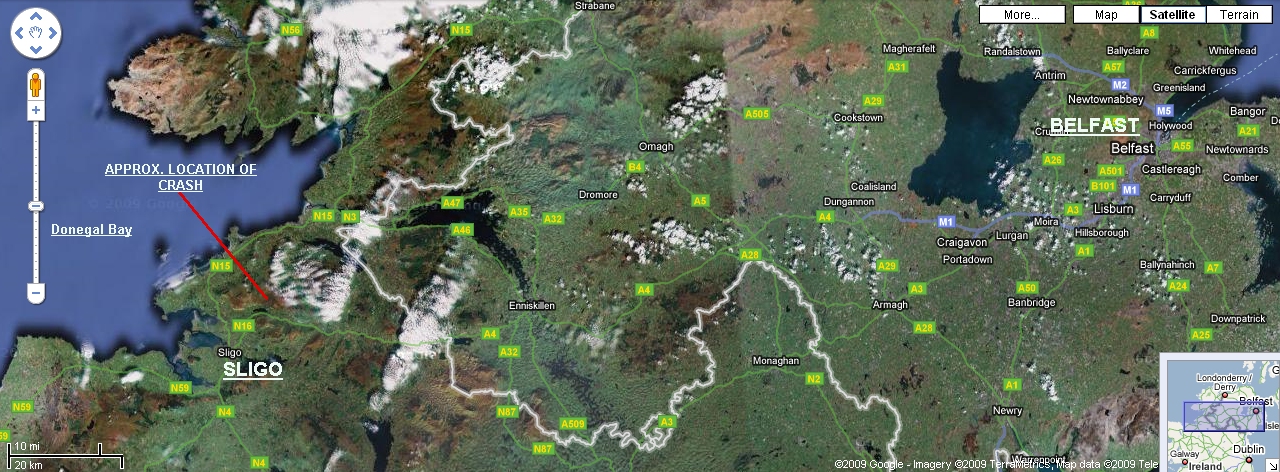
The image below from google maps gives an idea of the terrain in
the area. The dark areas on the mountains indicate the
areas of vertical or near vertical slopes in the area.
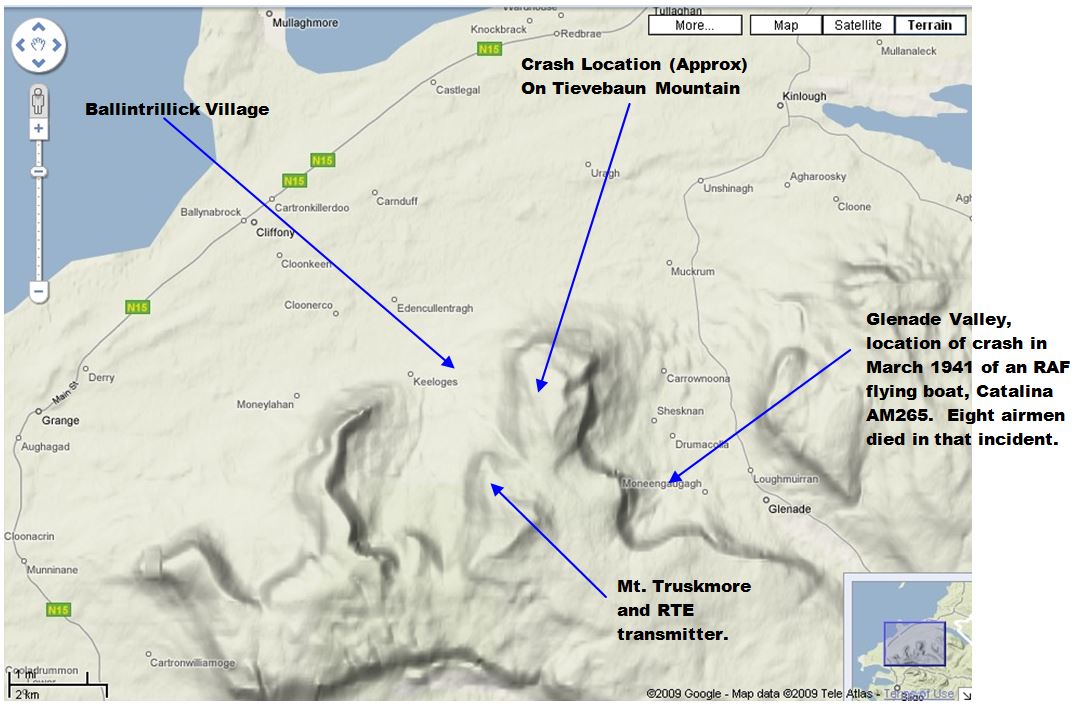
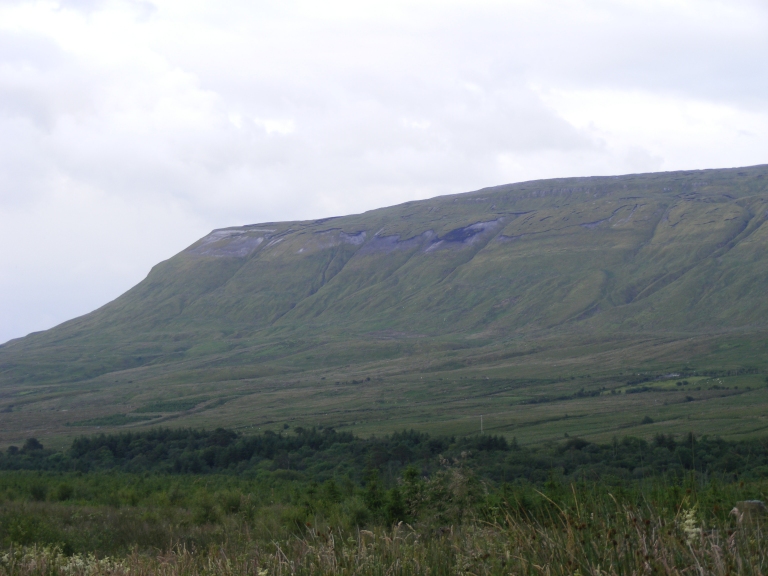
The photograph above of Tievebaun from the western side of the
Gleniff Horse Shoe road. The crash occurred above the dark
smudge on the mountain.
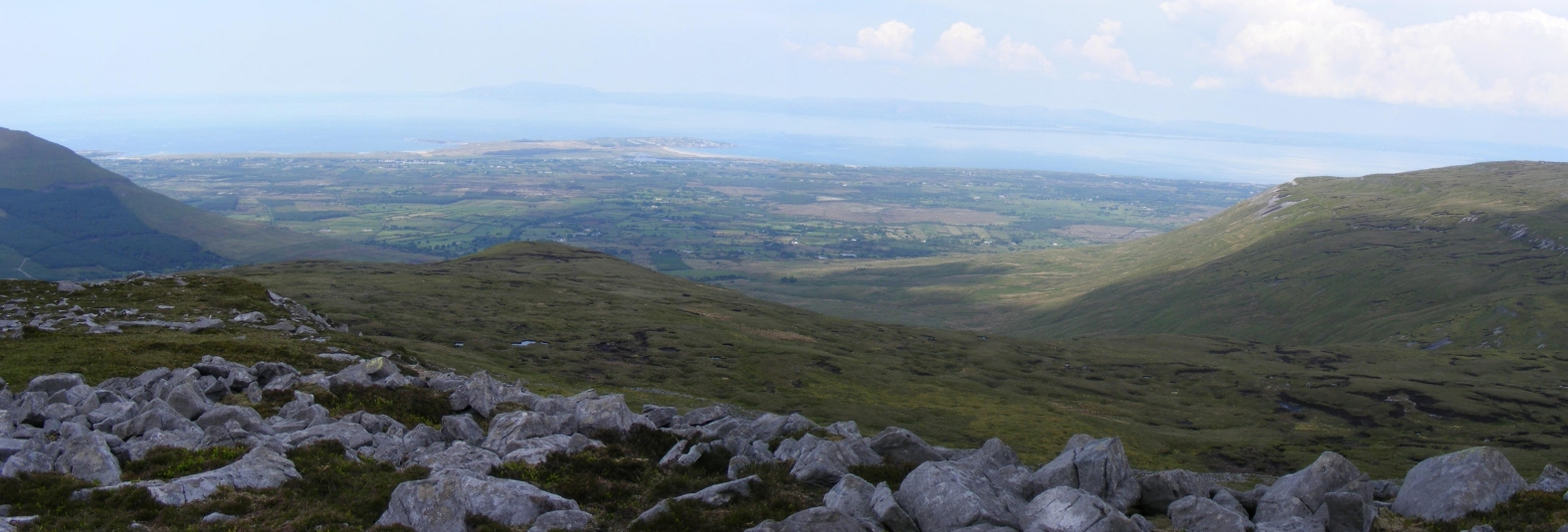
This composite image above shows the view North West out towards
the Atlantic. The town of Mullaghmore is visible on the
coast at center. The eastern slopes of Tievebaun are at
mid right, including the area of the crash.
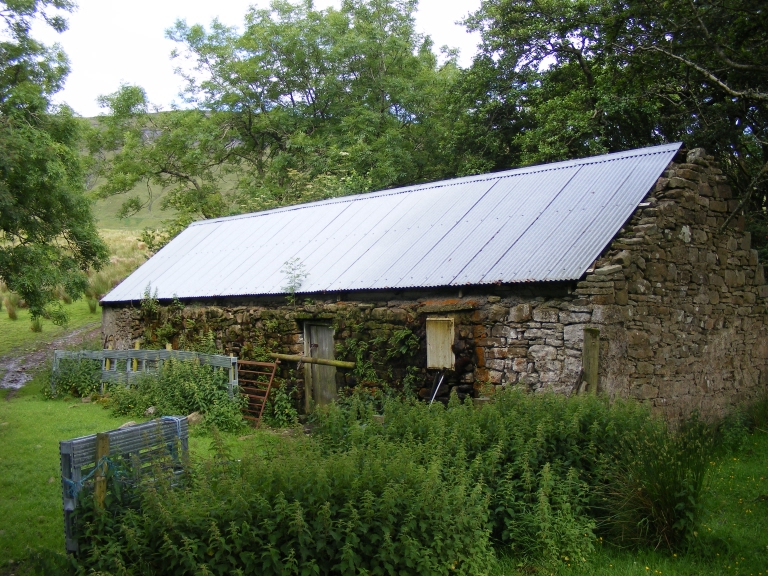
This is the cottage belonging to Mr. and Mrs. Dan Rooney, whom
Capt. Birthistle thought did such sterling work on the night of
the crash. Other households also gave aid to the rescue
workers and injured that night. (Photo: D. Burke)
And to complete this report, a photo of a surviving B-17G
aircraft which flies at air shows. This photo shows an
aircraft similar to the layout of 42-31420.
Particular differences would be the tail gun turret on 42-31420
would have been of an earlier design than on the aircraft below
and the aircraft would have been unlikely to have carried any
individual letters or unit markings. These would have been
applied upon arrival in the England when it was assigned to an
active bomber unit.
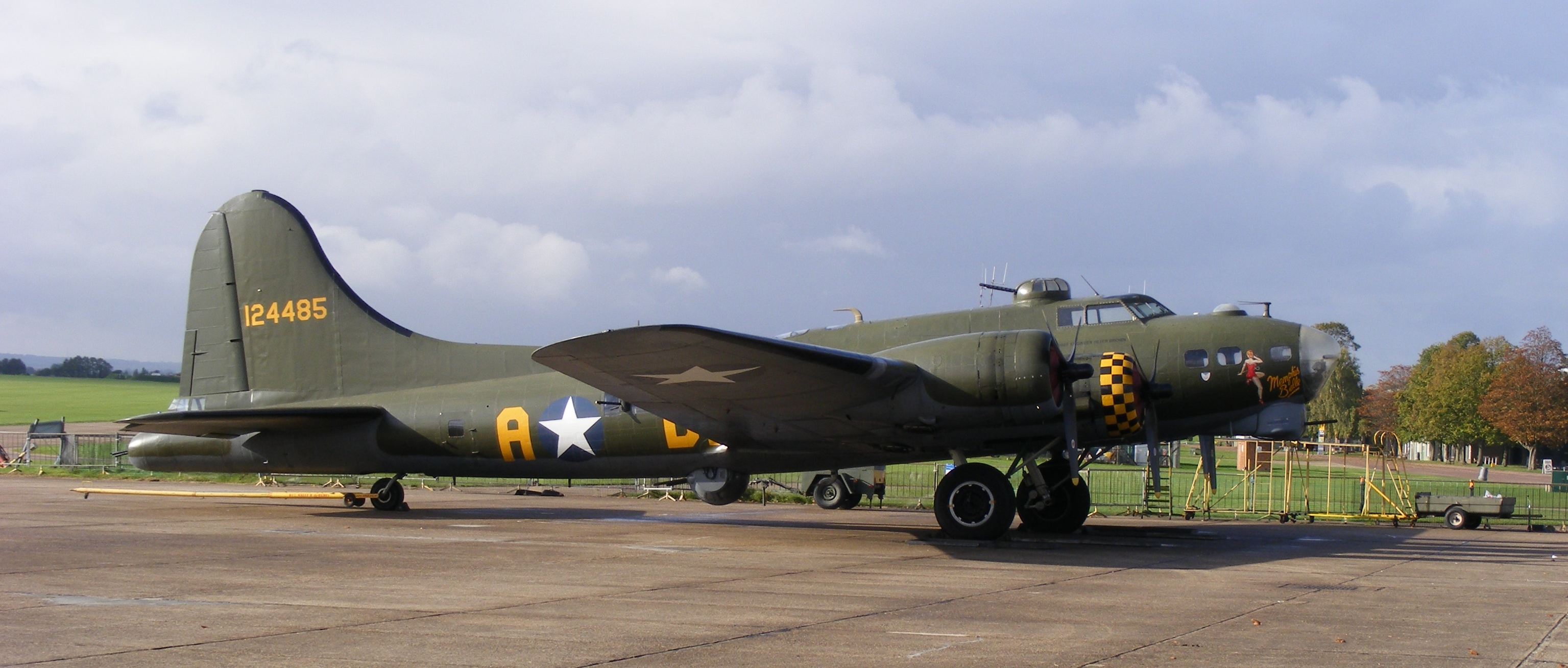
An image taken during a visit to Duxford Imperial War Museum
outside Cambridge in September 2010. This is a flying
example of the B-17, ‘Sally B’, operated from the Duxford
airfield. (Photo: D. Burke 2010) See the organizations
website: www.sallyb.org.uk
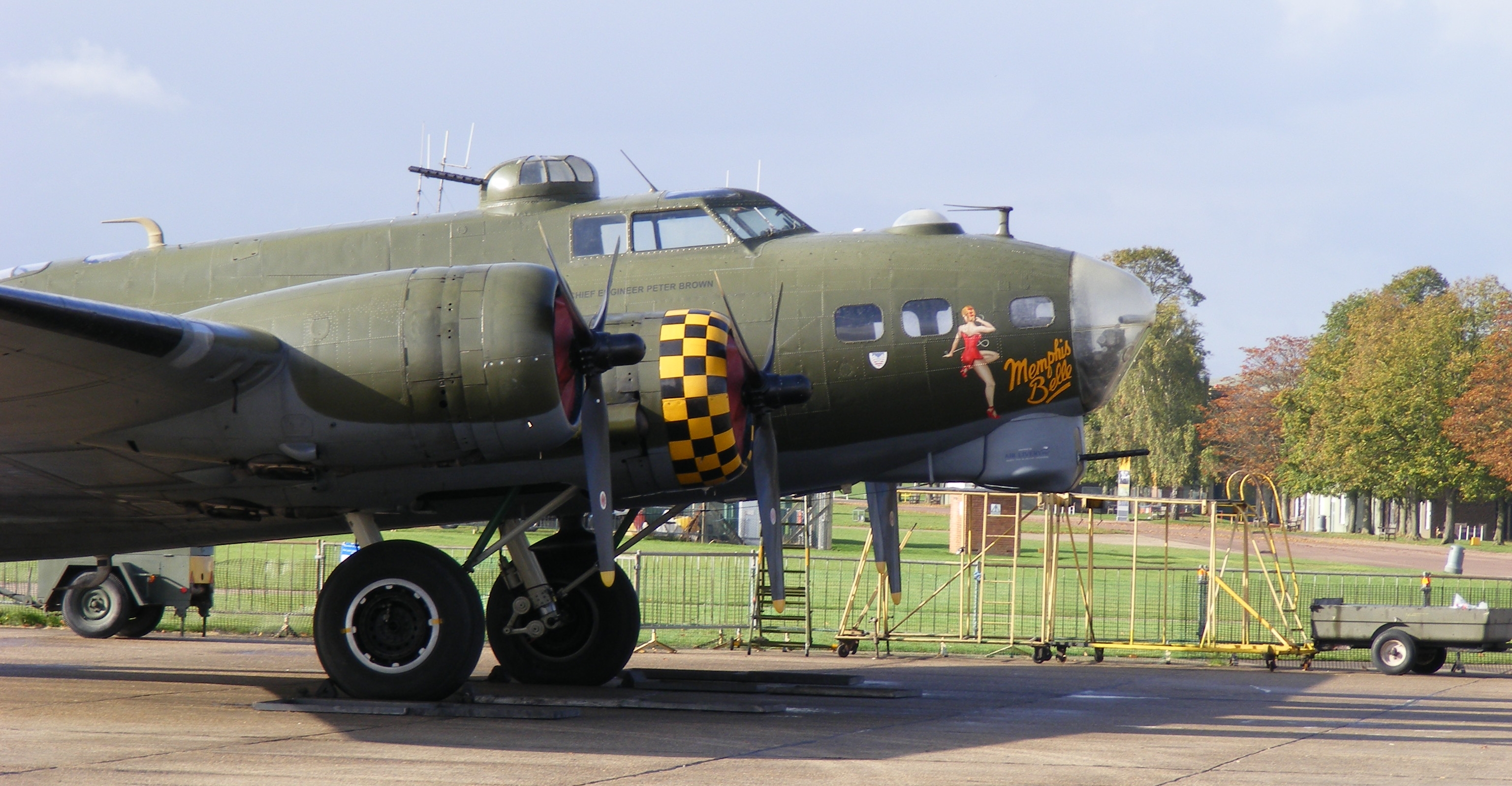
A close up of the nose compartment of ‘Sally B’, one can see
liferaft compartment cover, the area visible in Ron Lees photo
of the 42-31420 wreckage. (Photo: D. Burke)
Photo from the Warbird Depot Website:
http://www.warbirddepot.com/aircraft_bombers_b17-lsfm.asp
The contemporary Flight magazine of 4th May 1944 carried a
wonderful article on the B-17G as it was at that time a new
variant. That article can be hear.
Sources:
Irish Military Archives, Dublin, US National Archives via M.
Gleeson & M Kennedy.
Correspondences with family of crew members.
Correspondences with locals of the Ballintrillick area.
Databases at www.ancestry.com.
Information from T Kearns, R. Lee, M. Lozares.
Photos from T. Kearns, R. Lee, D. Rooney, M. Lozares.
If you can provide any help in finding relatives of these two
members of the crew I would be most grateful:
Sgt Adam J Latecki of Chicago, Illinois.
Sgt Emil C Drake, born 1908 in Arkansas to Nannie Fletcher and
Columbus Drake. His father was a soldier in the US Army before
World War 1.
The national museum in Dublin in 2012, had one of the wrecked
engines from 42-31420 on display in the Soldiers and Chieftains
area of the Collins Barracks Museum. In 2011, they put on
display beside it some items donated by Carl Williamson's
family. These photos are taken on my mobile phone so excuse the
quality. 